Tour de Greece – Greece day by day – part 2
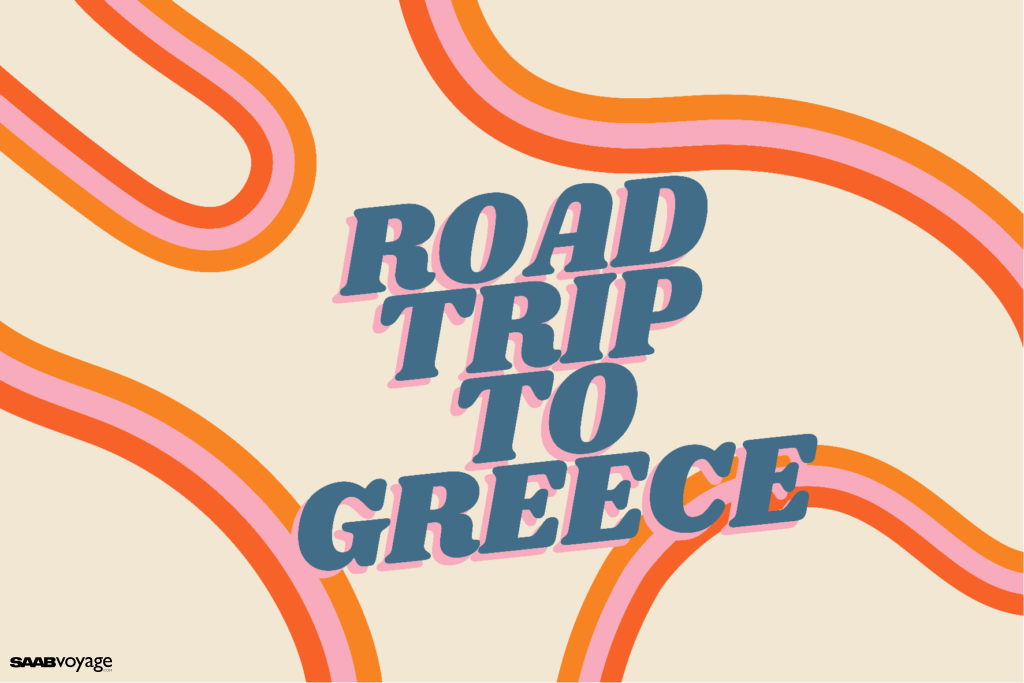
We liked Greece more and more every day. In the previous episode, we arrived at the foot of Meteora. The link is always waiting for you on the right.
Index
Friday – Meteora, Dodona
Meteora
Meteora is one of the most picturesque rock formations in the world. There used to be a lake here, at the bottom of which sediments accumulated. What you see now is the result of thousands of years of erosion.
In Greek, meteoros means flying in the clouds. And that’s pretty much what it looks like. 🙂 The rocks are over 500 m high, counting from the base. The place closer to the sky was settled by monks as early as in the 11th century, in order to devote themselves to prayers at a distance from the noise of the world.
Now the main attraction, apart from the sightseeing advantages, are the monasteries.
The climb was not as terrible as it looked. All in all, the earlier climbs had been more of a challenge (long and steep, on the motorway).
Meteora itself – beautiful, the place scenically is interesting and worth a visit.
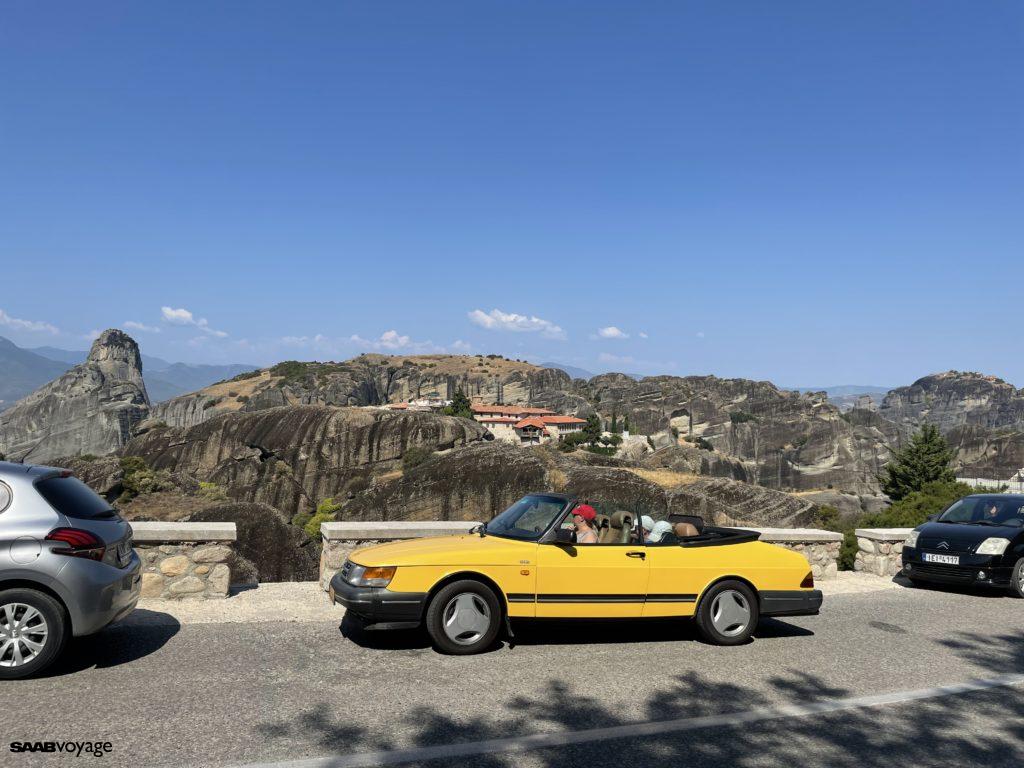
On the other hand, crowds of people, no place to park.
Please note: to visit the monasteries, you need to wear appropriate, respectable clothing.
And an interesting fact: photographic-viewing places cause a strange nervousness and hostility in people. Everyone would like to take a photo, without others in the background. And this is not really possible.
Dodona
The first oracle in Greek history. Here divination was made from the sound of oak trees and the flight of pigeons (no joke).
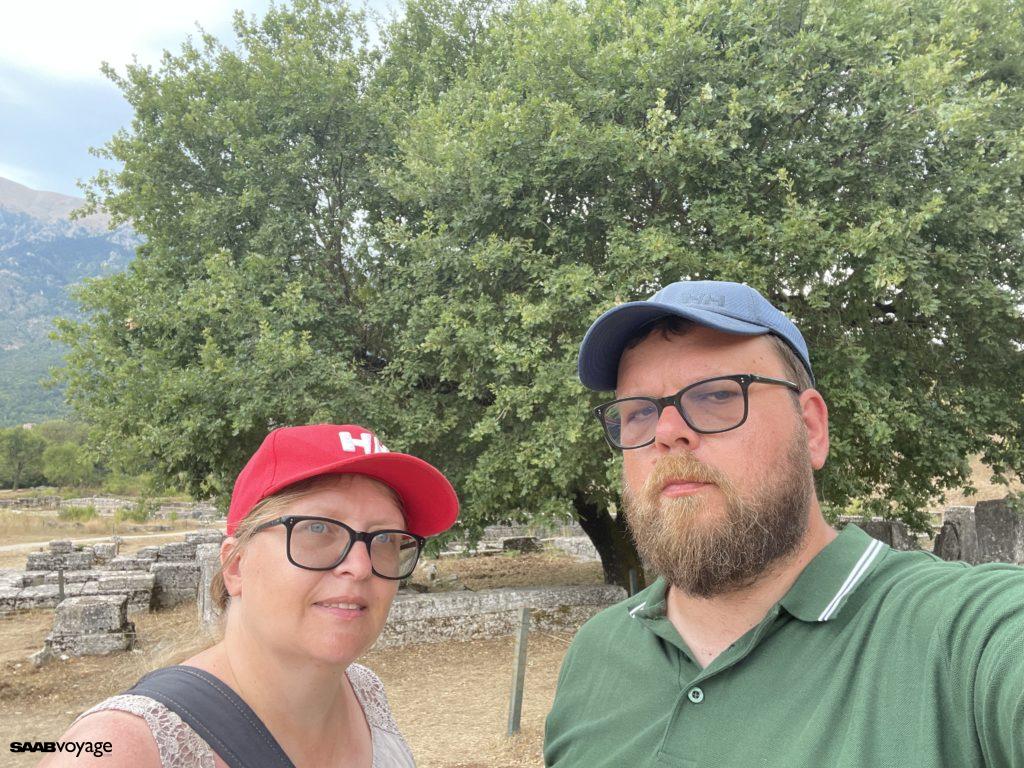
You can read about the discovery of Dodona on the Hellenopolonica website (in polish).
On-site you can see what remains of the amphitheatre, temples and other buildings. One of the ancient temples was converted into an early Christian basilica, but it still ended up as a ruin.
You can see that restoration work is going on. Generally, with ancient ruins, the idea is not to restore them to their original state, but to show visitors what they might have looked like.
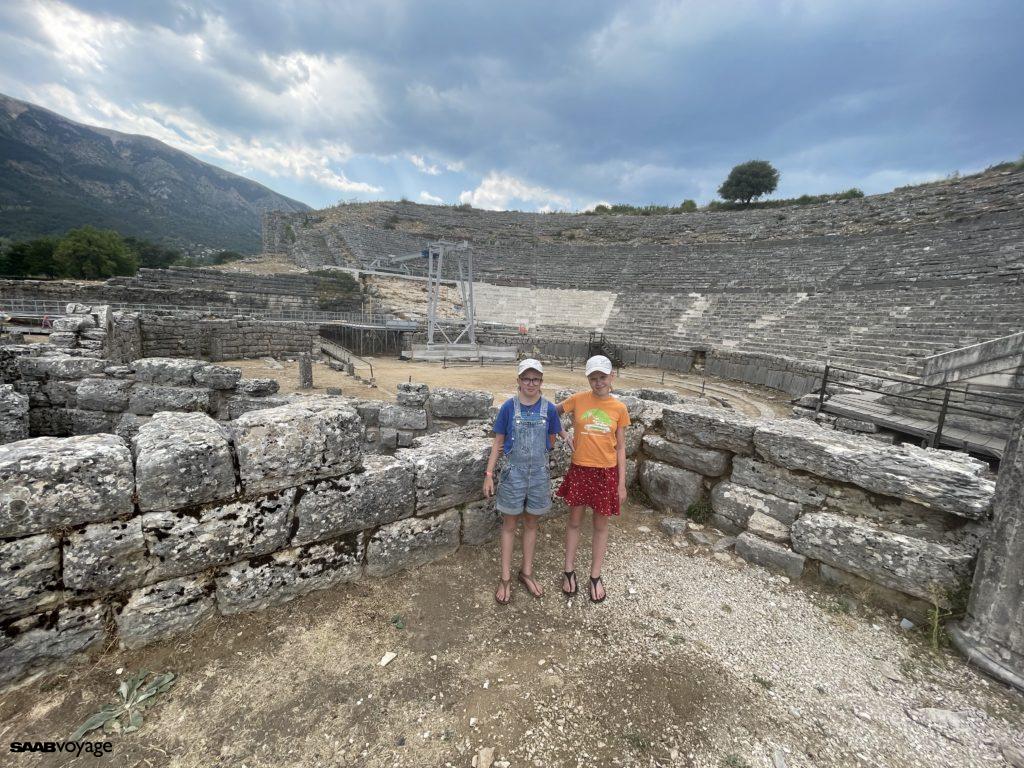
We continued driving to Patra.
We drove through the mountains, along narrow winding roads, passing small towns with small pubs. The locals sit in them and drink what they like and what they can afford, and just talk. A nice view.
We arrived in one of the many small towns by the sea. We saw an unprecedented sight: a driveway allowing people in wheelchairs to get into the sea. I wonder if and when this will be possible here.
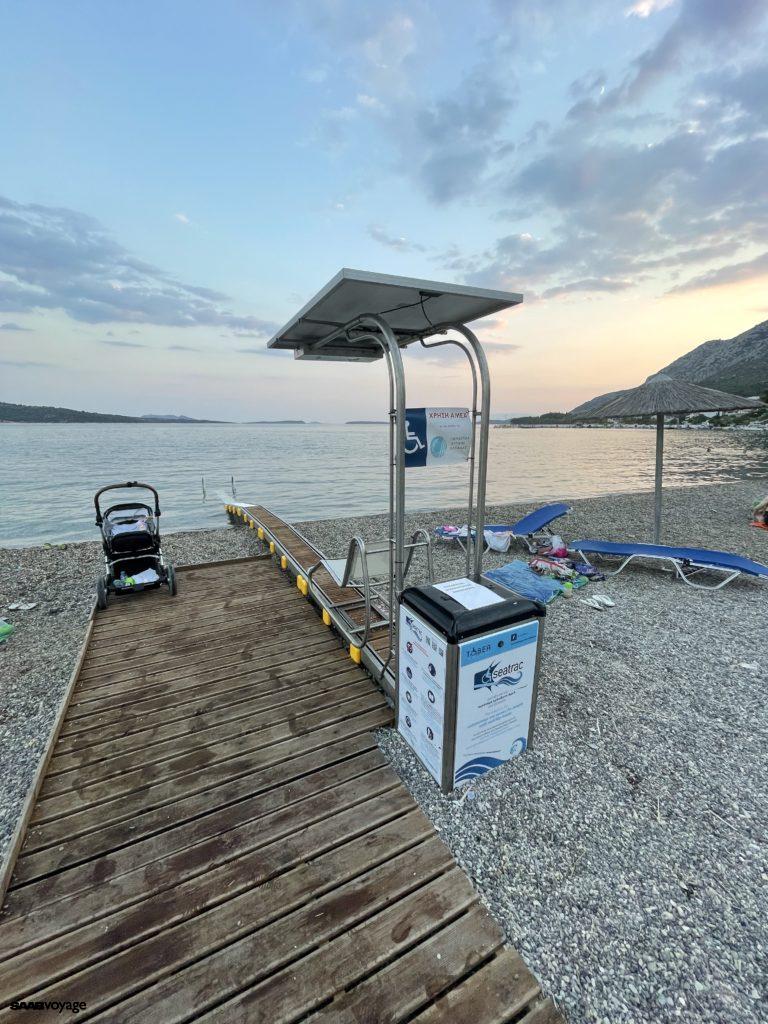
This is where we dipped our feet into the seawater for the first time. The stony beach is not the favourite one.
We then crossed the bridge over the Corinthian Gulf at night. (The Corinthian Gulf is not the same as the Corinth Strait, which will be mentioned later.)
We had a standard night booked in a strange place. This time it was a flat above a car showroom. As well as accommodation for us, there was also a lockable car park for the car.
Interesting fact: the key to the padlock for the gate hangs on a hook on the other side. A secret for insiders only.
For a whole 50 euros we had a suite with a marble bathroom, white towels and a full kitchenette. And ice cubes in the freezer.
Wine, feta and tomatoes were brought to the table.
Saturday – Olimpia
Olympic day
Before leaving, we were warned that everything was on fire in the area. We checked on google maps what the emergency situation was.
We also checked here: Emergency Copernicus (by the way, it’s an interesting ticket system collecting information about all natural disasters in Europe). However, we found the most recent and first-hand information on the fanpage of a local pub in Olympia. They wrote that they had preemptively closed for two days, but were already open and inviting guests for an evening of Greek song.
So we went to the complex of monuments in Olympia. It consists of:
- archaeological area,
- the museum of the history of the Olympic Games,
- archaeological museum and
- museum of the history of the discovery of Olympia. It was closed.
Interesting fact: at the ticket office, there was a lady whose only job was to say: tickets? Next ticket office. Cool job.
To visit everything, 5-6 net hours are required.
We additionally spent an hour for coffee and rest. It is worth arming yourself with water and sandwiches. It took us half of the time to walk around the excavations. The area is huge, very interesting and really worth looking at everywhere. It is one of the most fascinating places on our trip.
Importantly, if you visit an archaeological museum in a superficial and unintelligent way, then at the excavation site you will not know what you are looking at, what it is about and what the context is. And if you don’t understand what you are looking at, it is difficult to understand what you are really seeing. Because here are buildings from different eras, in one place.
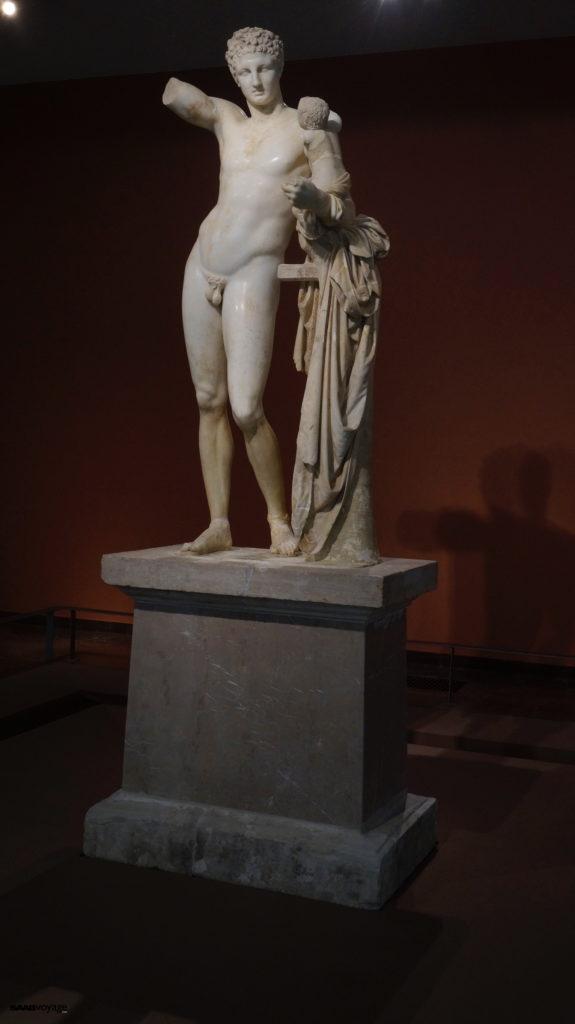
The excavations are guarded by guards with whistles. Immediately you can hear that some moron is stepping on the stones, i.e. on the column, which is over 2,000 years old.
It’s worth having that skill, to be able to imagine the Temple of Zeus in its full glory. To stand in front of the ruins and see in your mind what it was like when it was.
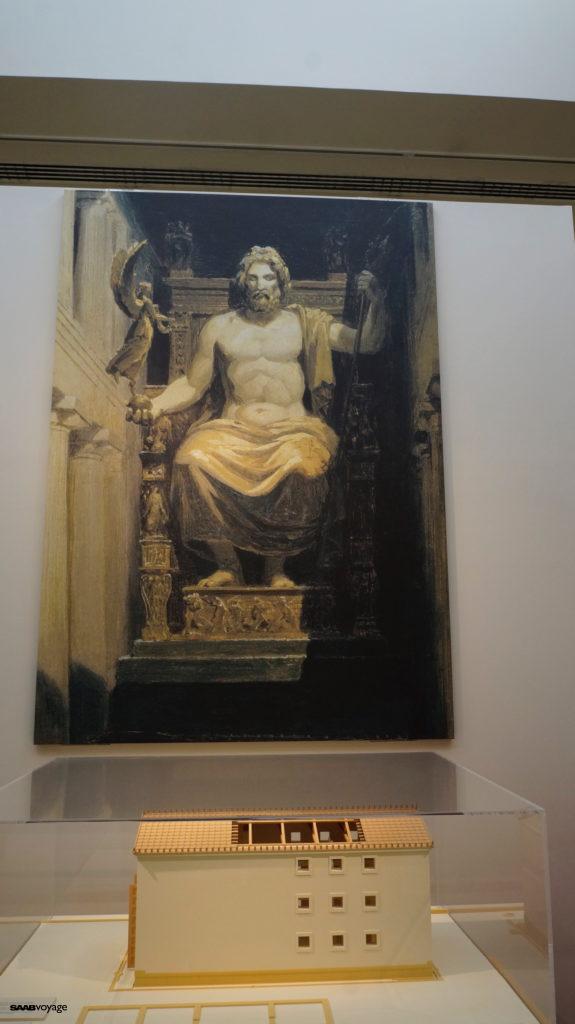
We saw people with VR goggles – there is software that allows you to look at the Olympic sights right there on site. For hire on-site, however, this is not advertised.
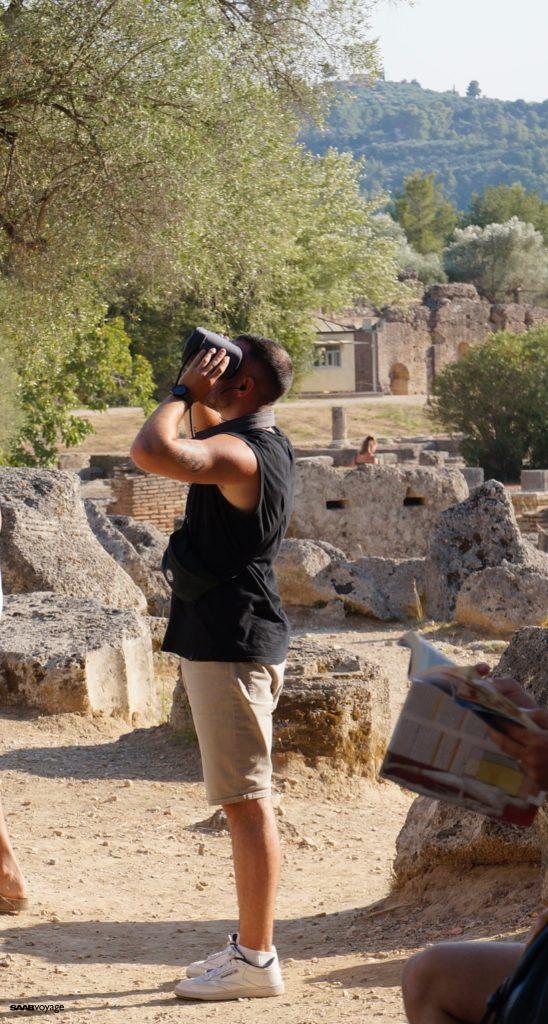
The other extensive part of the excavations is the stadium. Just a rectangular lawn, but this is where the games themselves took place. So if someone didn’t understand what the Olympic museum was about, they won’t understand here either.
Unfortunately, here you can see how much Greece was neglected. We came to the conclusion that the current state of Olympia is due to the fact that the Germans gave away some of the pieces so that there was something to rebuild (they gave away something that they had taken away themselves). The Germans and Italians gave funds for reconstruction and the Greeks… The Greeks allowed themselves to dig in.
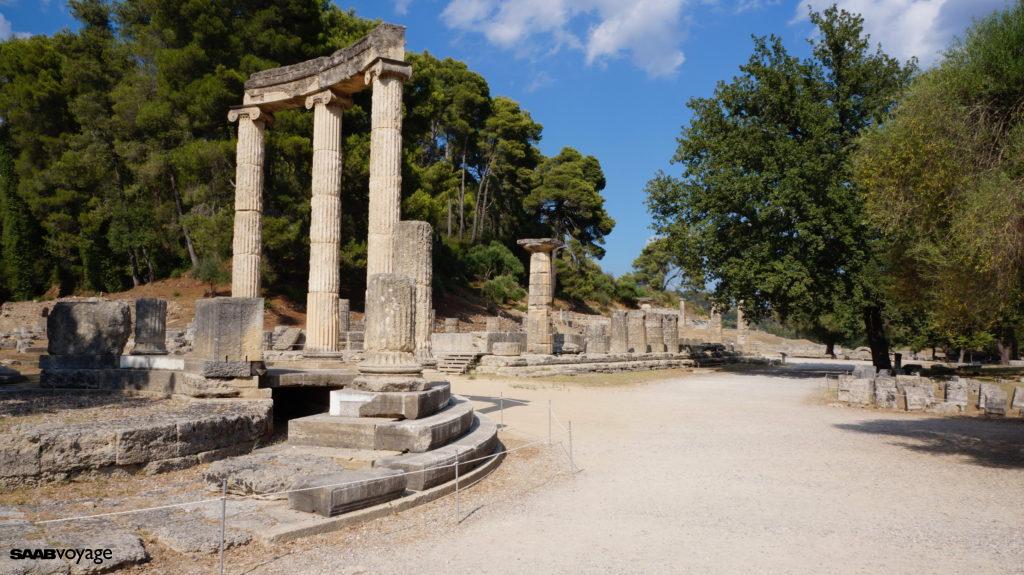
Back to the Olympics…
The Games themselves, were a religious event and a complete process. First, preliminaries were held in the cities. Then SMS messages (joke!) were sent out on horseback to inform everyone potentially interested of the exact date of the competition. A month before the Games, the athletes would gather in Elis, where they would undergo final training and coaching, not only of their sport, but also of their morals. For the inadequate athletes, the Games could be over even before they began. A procession walked from Elis. This was followed by the official lighting of the Olympic torch. The games themselves lasted five days. The first one was a day of prayers, the next three were the competitions of the athletes and the last one was the prayers and awarding of prizes.
And what were the prizes in the games? First of all, the winner gained the privilege of having a statue erected in the temple of Zeus. He would return to his city as a hero. Firstly, he would enter the city on a four-horse carriage, through a hole in the defensive wall broken in his honour. Secondly, he would get exemption from taxes, free food in the city’s eateries, and tickets to the theatre for an honorary seat.
There were also women’s games, on a different date and with fewer disciplines. The prizes were also different – the winner got a cow.
What was crucial about the Games was that, beyond physical fitness, morality and honesty counted. If a participant was caught cheating, he was expected to deliver a statue of Zeus as a warning to others, which, signed with the name of the offender, was placed in the alley leading to the stadium. In ancient times, the avenue of shame collected 16 such statues. In addition, the dishonest competitor was banned from ever returning to the Games.
A curiosity for the end. At the archaeological museum in Olympia, we found out that already in ancient times there was a problem of private cups disappearing from the workplace. On a mug owned by the famous sculptor Phidias, the inscription reads: “I belong to Phidias”.
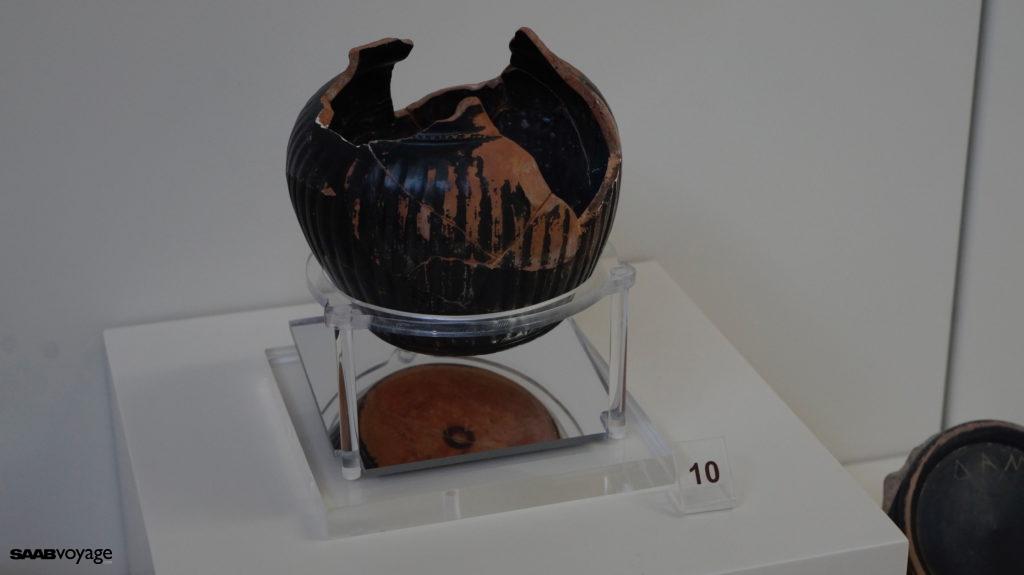
We wrote about fire protection in Olimpia in this post on our Fanpage:
On the way to our accommodation, we stopped at Lidl. Standard shopping: tomatoes, peppers, smoked meat. And here beware, you have to be vigilant because you can unwittingly buy foreign products (Holland, made in the EU).
Fuel at Shell is still €1.8 (95 vPower), but this no longer surprises us.
We arrived in Messini, where we had booked accommodation. Small town, narrow one-way streets, no parking spaces. We finally found a place two blocks away, next to a rubbish dump and a car that looked as if it was no longer able to drive. And in the morning it was just a few meters away.
Sunday – Mystras, Sparta, beach
From Messina, we did not take the obvious wide road to Sparta. We opted for the advanced version, through the mountains. The views were beautiful, complete with twists and turns, craggy rocks and stone-carved arcades.

Mistra
Mystras is a medieval city – a fortress. It is said to be the best-preserved example of a Byzantine city. In total, the city consisted of a palace, a monastery, outbuildings around the monastery and churches. It was situated on a mountain slope, which did not make life easy for the inhabitants.
In our opinion, you should visit at most the upper part.
Sparta
Spartan relics are few, after all they didn’t bother with buildings. From the interesting objects we saw: a modern monument to Leonidas, a plaque with the winners of the Olympic Games, both ancient and modern, from Sparta, a convertible crocodile and 9000.
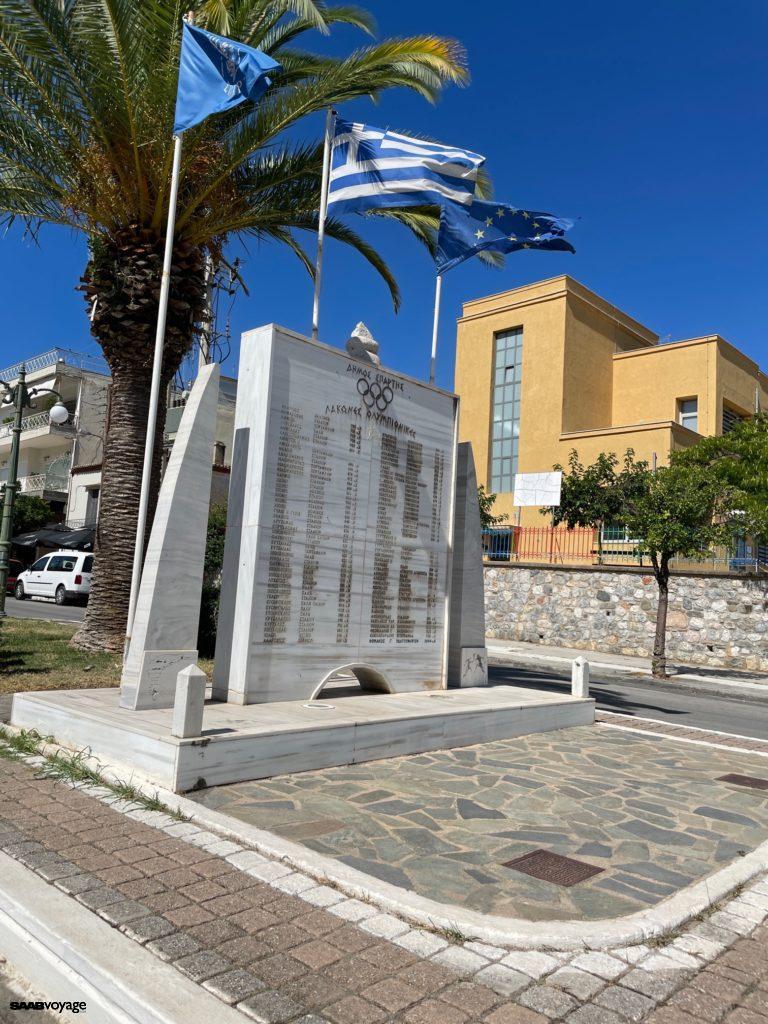
Note: 15 August is a holiday in Greece and generally everything is closed. Thus, we did not manage to visit the olive and oil museum.
…And onwards
We went to feel like real tourists on the beach. We drove through orange and prickly pear plantations until we arrived at this wonderful place:
There is a nice cove with a sandy beach. Its decoration is a shipwreck.
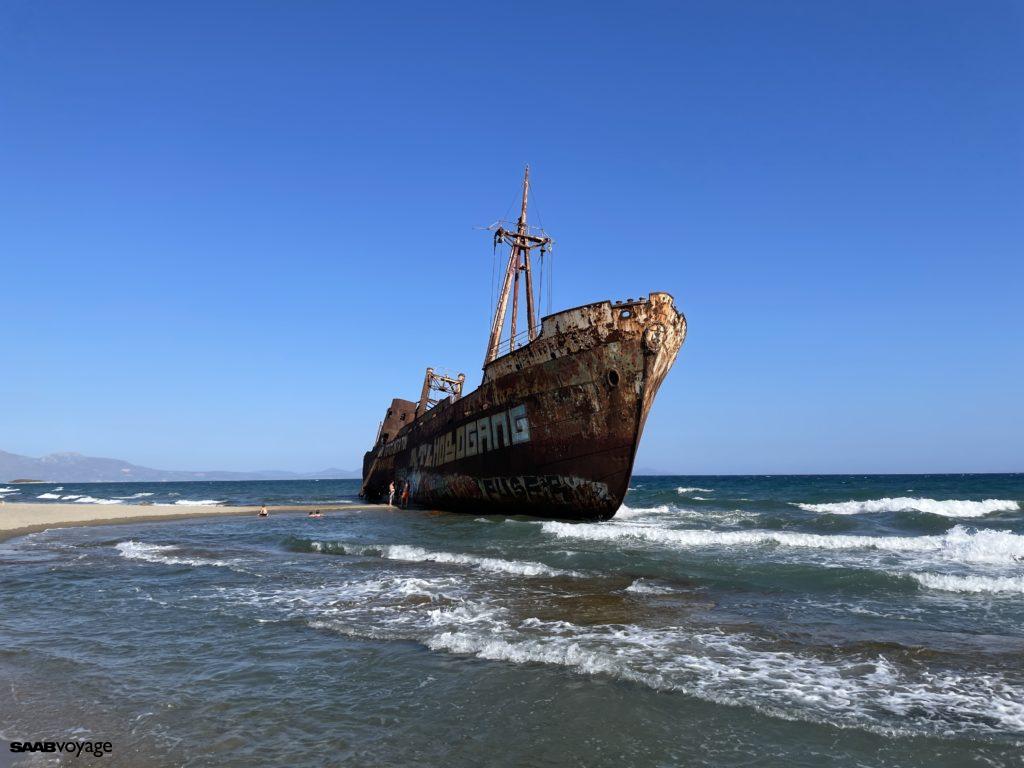
It’s worth hurrying, because rust eats away at the wreckage and in a while it will fall apart.
It is not crowded, there are no parasols. As the beach is not commercial, there is no infrastructure or toilets. But there is no stench in the bushes. Perhaps this problem is solved by the only pub on the beach (which does not emit loud music).
The Greek sea looks like this:
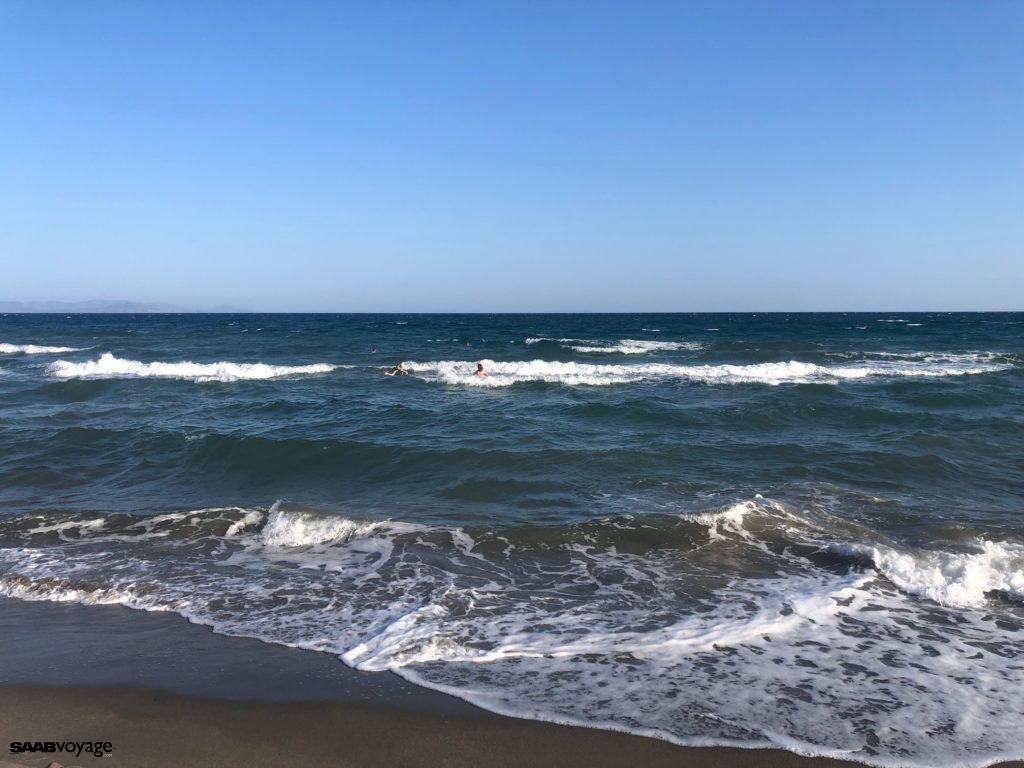
Of natural interest, we saw secured, marked locations where sea turtle nests are. The baby turtles are hatching!
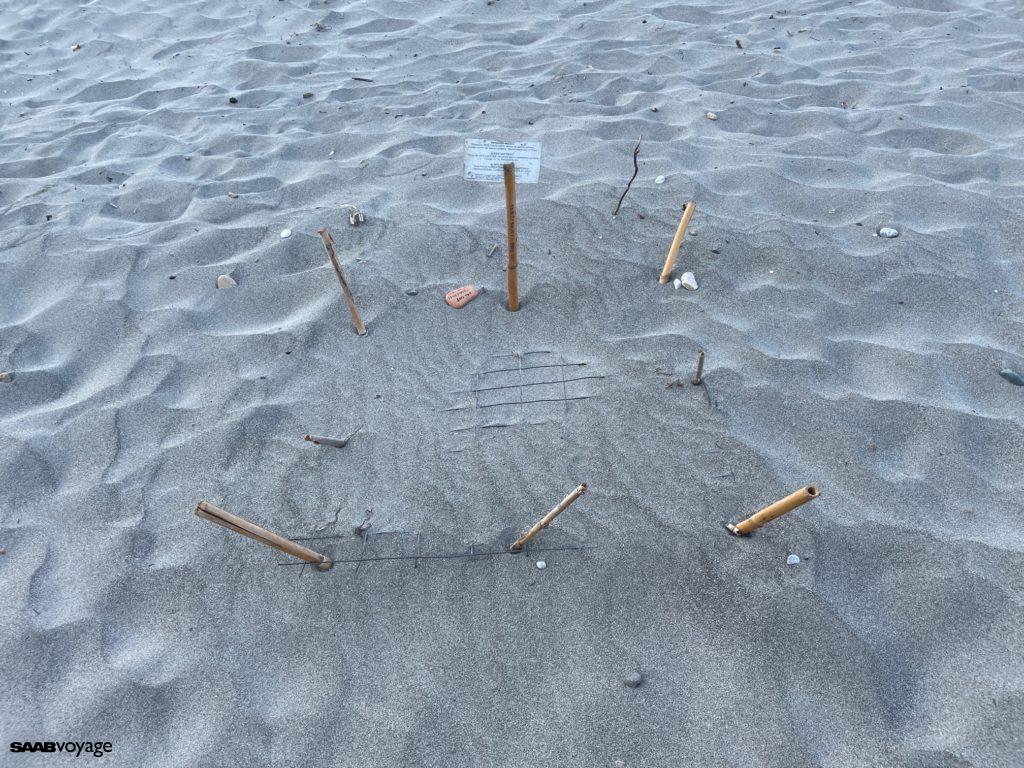
On the way back we stopped at an orange plantation. And you know what? An orange straight from the tree tastes incomparably better than even the freshest one from the market.
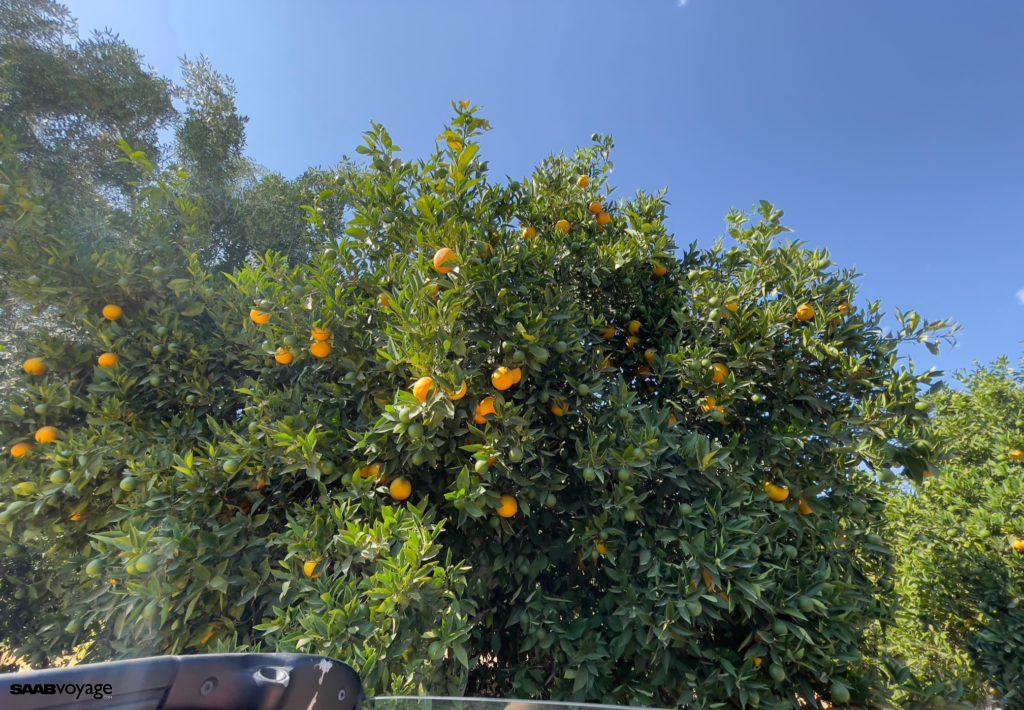
We reached Monemvasia in the dark, so there was no point in stopping. We drove on.
We were driving practically in the dark, so we couldn’t see if we had anything to be afraid of.
We pulled into a tiny village in a cove for the night. There were even no street names here. Our hostess was waiting for us in a café, but she did not quite understand that in a crowd of people we might not know which person she was.
We ended up spending the night in an old house, with no address but a big key.
But how did we end up there? It is very difficult to find accommodation in this region of Greece, especially at reasonable prices. We had booked in a completely different place, but the host there said he didn’t want to rent us a room after all. Because he did. That’s why we usually use booking.com – they had to make an effort and find us another place at the original price. And there were no reasonable places in the area. So we modified our route a bit, and instead of a room in a guesthouse, we got a whole house. The price was also accordingly higher, but the difference is covered by booking.com.
In this way we found ourselves in a place, the address of which is difficult to determine unambiguously, supposedly Paralia, supposedly Kyparissi – the easiest way is to show it with a finger:
Tiny, cramped, for one car to enter, another must leave. Narrow one-way streets, plus two grocery shops that close at 6pm.
There is only one road to the village, accessible only by car (or boat). One wonders how the residents do major shopping? Even buying socks must be a challenge.
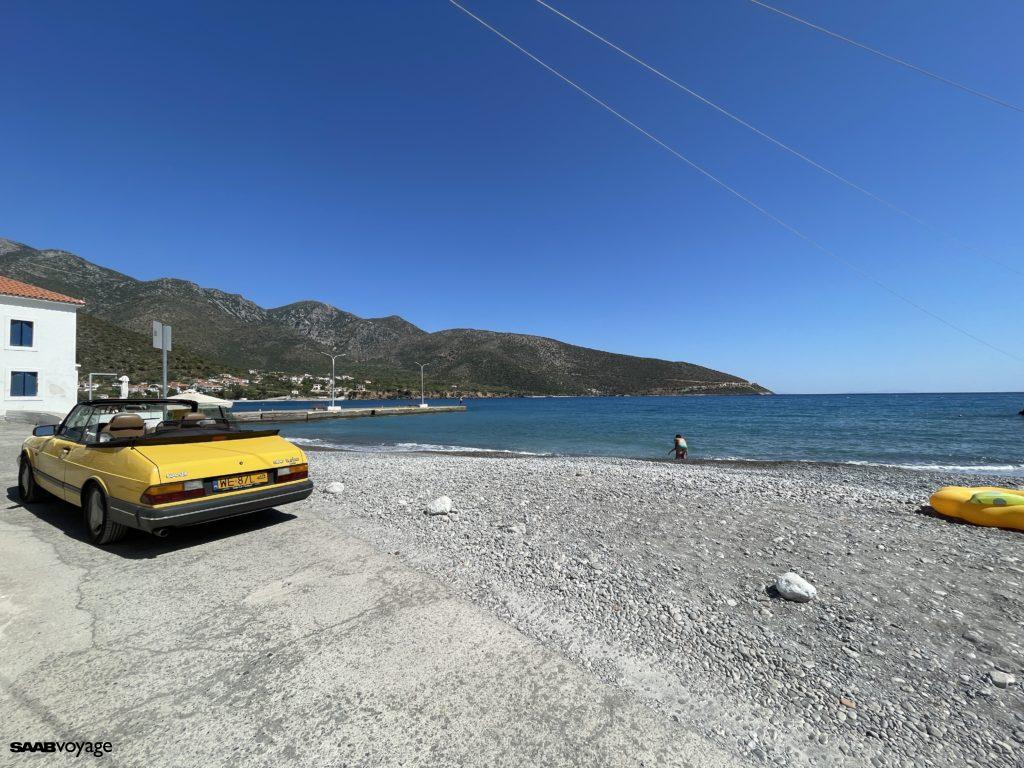
Monday – Mycenae and Epidavros
Mycenae
We went to Mycenae. We will not write about Mycenaean civilization and Agamemnon, who did not pay attention in history lessons, will not understand anyway.
Mycenae (and also Troy) is associated with the figure of Heinrich Schliemann. He was a German merchant who, having amassed a fortune, decided to fulfil his dream and become an archaeologist. Despite the fact that the lion’s gate leading to Mycenae stood on the top (!), it was Heinrich who started digging around (based on his interpretation of the Iliad). And he dug up the treasures of Mycenae. On the other hand, it must not be forgotten that he had a rather peculiar approach to his discoveries – if the excavated artefacts did not match his theory, the theory remained and the artefacts disappeared.
Mycenae itself as a building is amazing. The finds are no less impressive. It is worth realizing that Mycenae was built after the Bronze Age, some three and a half thousand years back from the present time. And now let us think about what was happening at that time in our beautiful country and whether our civilization existed at all.
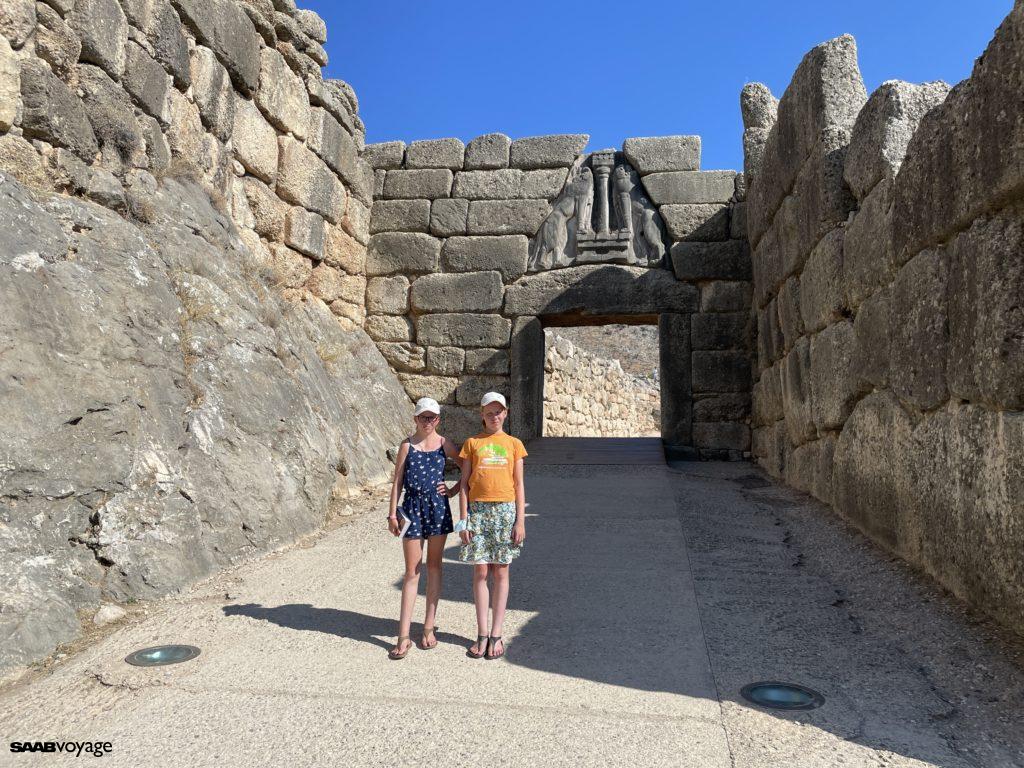
Meanwhile, the Mycenaeans were forging the posthumous masks of their leaders out of gold.
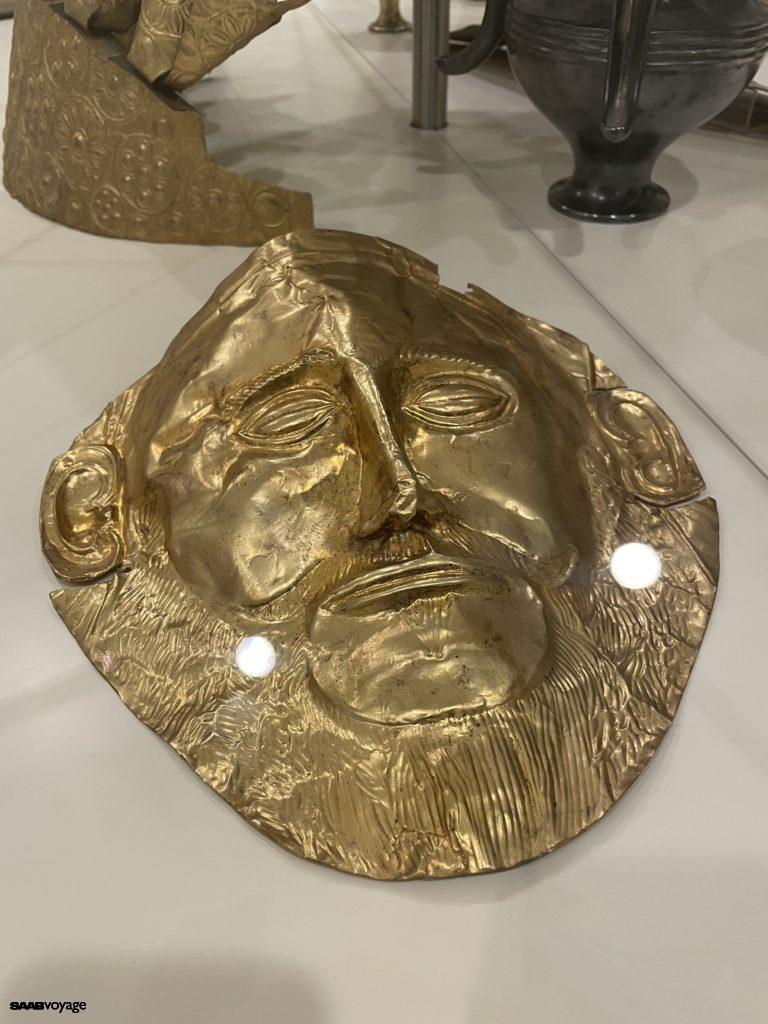
A total of 14 kg of gold was found in Mycenae. Here in the archaeological museum (as is standard, every interesting place has a museum and an archaeological site, it’s a permanent arrangement) there are copies of the gold artefacts, as well as other items pulled from the tombs of the emperors. The originals are in the archaeological museum in Athens, about which we will write later.
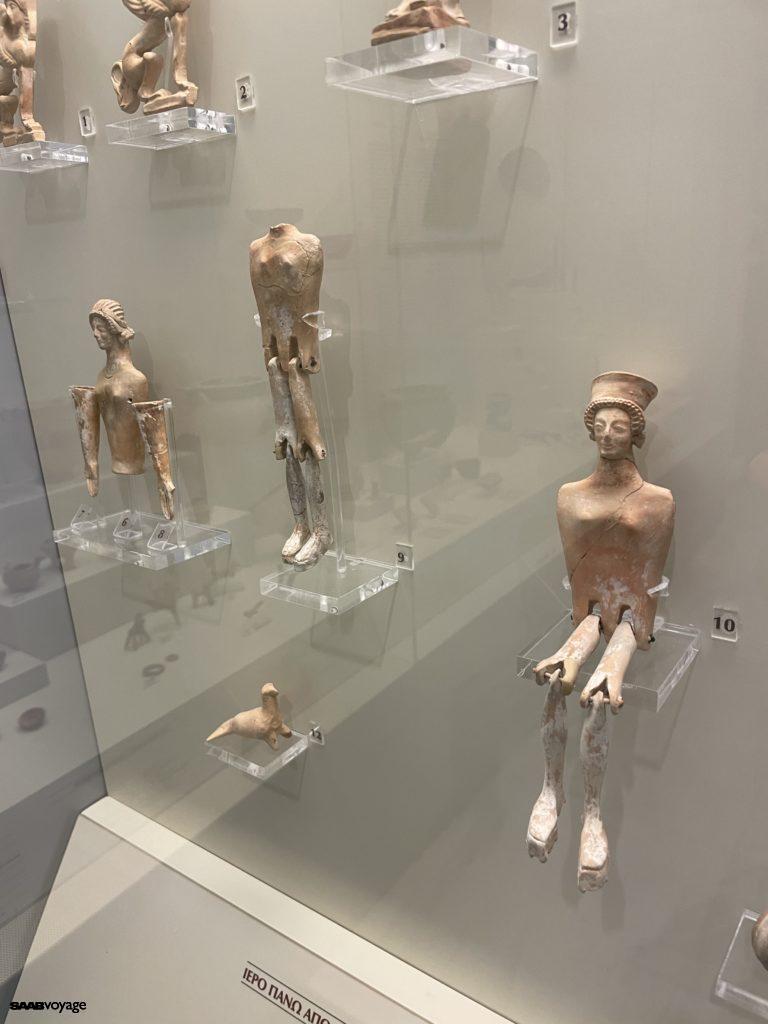
Epidavros
Epidavros is a place famous for two reasons. There is the great amphitheatre and the temple of Asclepius (actually, an ancient sanatorium).
In the “sanatorium” the treatment process was quite simple. First, the sick person was fed and washed. And he could finally rest. Under such conditions, the chances of recovery from any illness increased significantly. The patient was supposed to sleep until he dreamt the way he was to recover.
Interestingly, foreign (from the perspective of the Greek world at the time) patients were also served at the sanctuary. To meet their religious needs, a temple dedicated to the Egyptian gods was built.
In the archaeological museum, we found some fascinating exhibits. Large stones on which a full accounting of the temple was engraved. It is known how much it cost to build the sanctuary, where the building materials were brought from and for how much, how the temple worked, etc. Descriptions of illnesses and confirmed cures have also been carved into the stone.
Secondly, there is a display case with ancient surgical instruments. You can see that not much has changed in terms of tweezers and scissors.
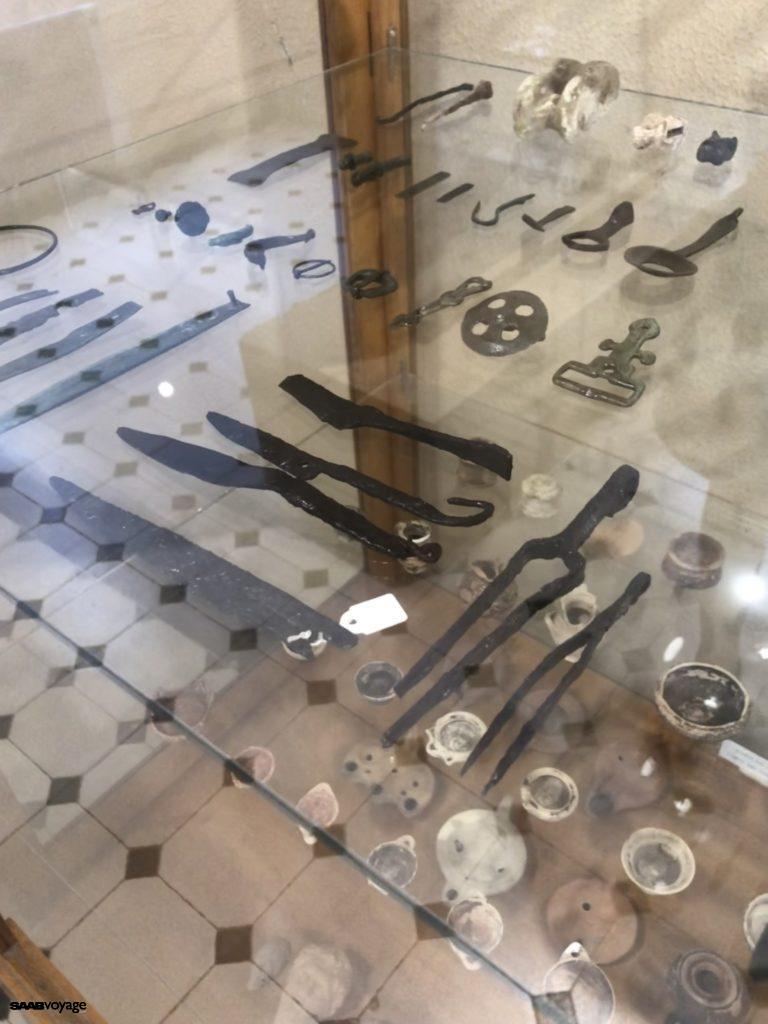
In the large amphitheatre, which is quite well-preserved, concerts are also held in our times. It is said to have excellent acoustics. As it is still in use, there are two ways to get to it – the usual way up the stairs, and around, but with a gentle ramp.
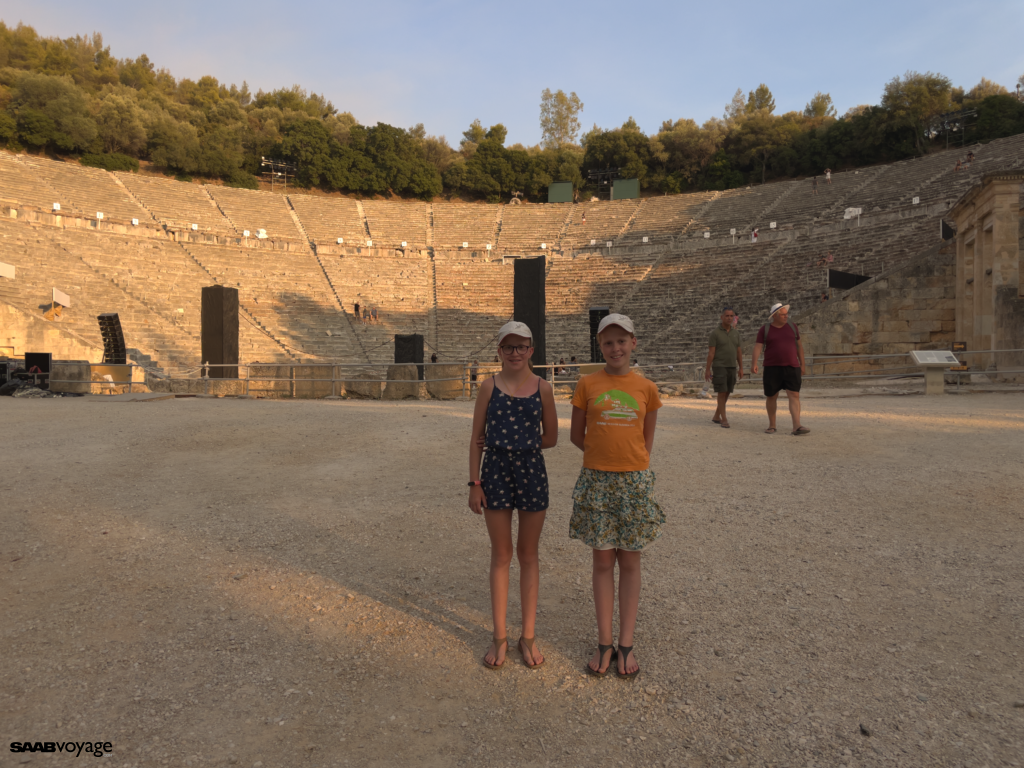
We planned to end the day in Corinth. We had a slight problem getting there. Hence a note for the future: read the welcome message from the host carefully. Otherwise you can confuse Corinth with Old Corinth, then you can find a guesthouse with the right name but in the wrong location. In the end, we arrived where we should. But it took us some more time.
Our accommodation was in a cottage with a very nice lady who spoke excellent German, but English was a challenge for her. But she left us breakfast in the fridge. And just over the fence was ancient Corinth.
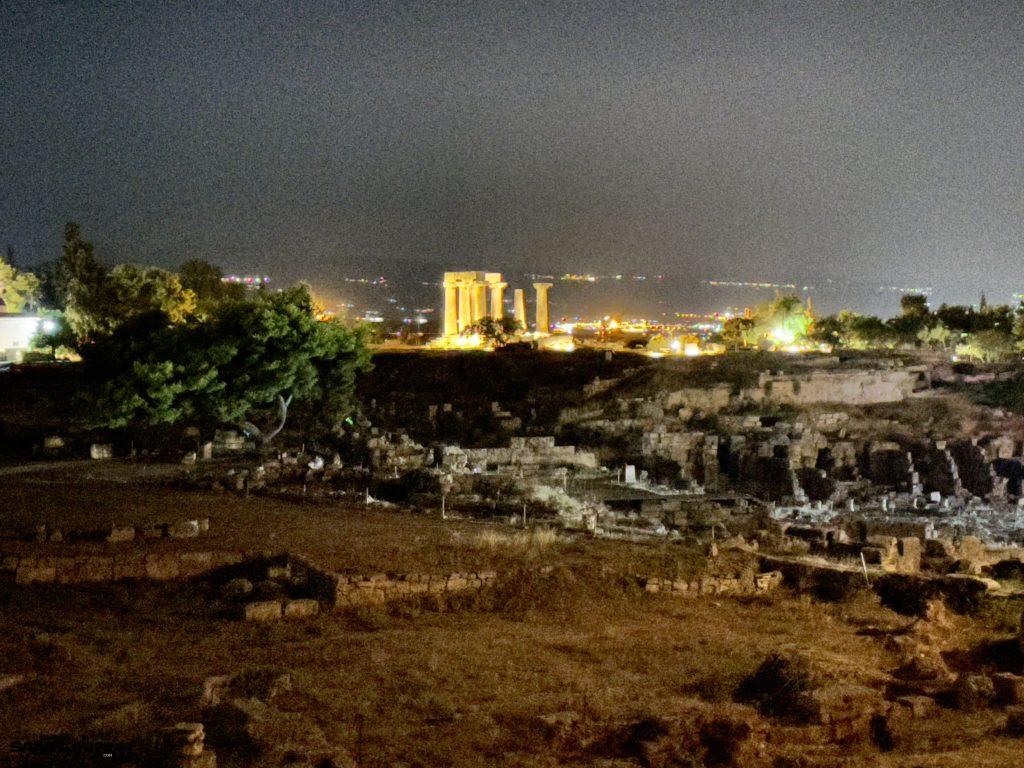
Thursday – Corinth and Sunion
Corinth
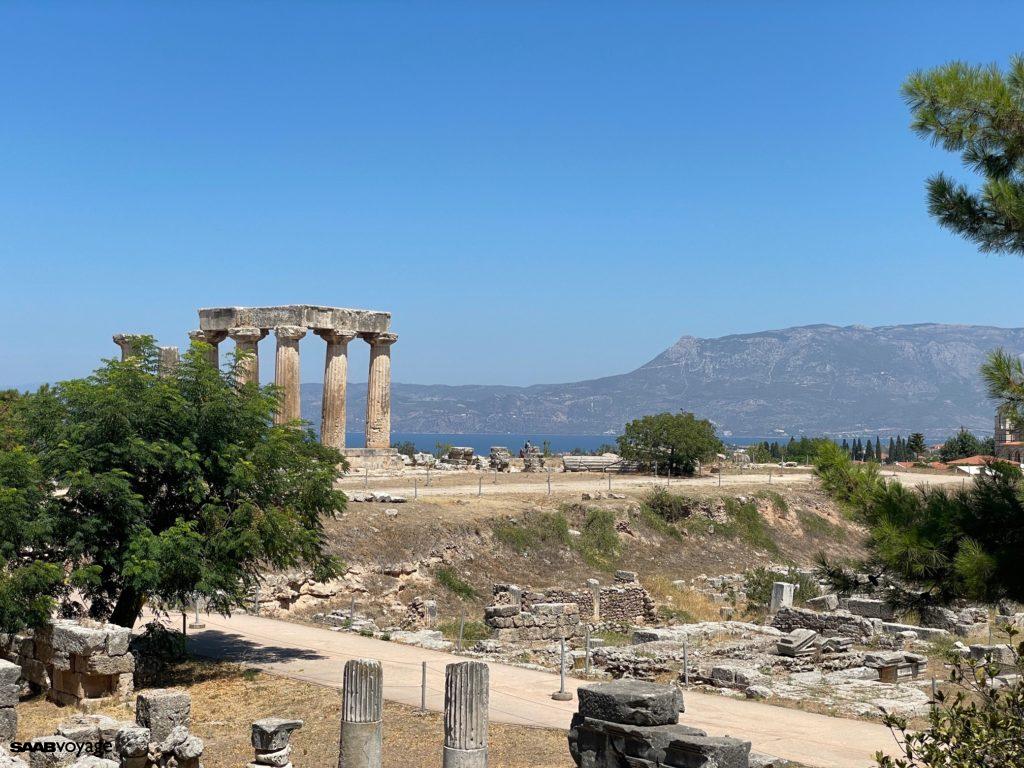
Standard arrangement: museum and archaeological site. In this museum, we saw a kouros for the first time. A kouros is a statue of a young man, with a mysterious smile, his arms along his body and his left leg in a crouch. Such statues were placed either as votive offerings in temples or on graves, regardless of the age of the deceased. Interestingly, there was also a female version, or kore, as opposed to kouros – clothed.
These Corinthian statues just happened to have been dug up in someone’s garden.
This museum was brazenly robbed by a gang of Greek thieves in 1990. Most of the stolen works were recovered. A more detailed description of this incident can be found here.
Importantly, the detailed documentation produced by the American School of Classical Studies at Athens (ASCSA), which worked on the Corinthian discoveries, had a particular role in the recovery of the treasures.
Among the highlights, there is a bas-relief which was the inspiration for the Statue of Liberty.
The archaeological site, is the entire ancient city – Corinth. Pavilions, houses, temples, fountains. It’s huge. Do you remember St Paul’s letter to the Corinthians? That’s where the addressees lived.
Detailed descriptions of the sites at the archaeological site can be found, for example, at this link.
Ancient Corinth was equipped with a full-scale hospital, the temple of Asclepius (see Epidavros above). The hospital functioned for about 800 years. Some quite interesting collections in the museum remain of it. These are Thanksgiving statues, depicting body parts that were affected by a medical problem. Here we have arms, legs, brains, breasts….
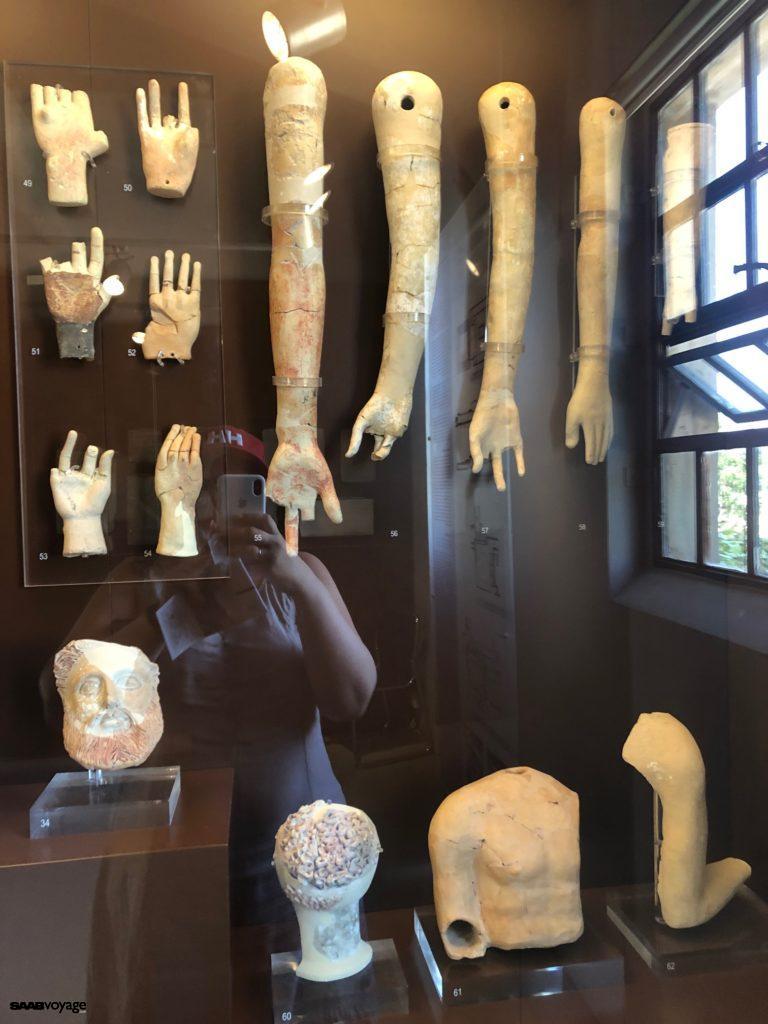
And finally, a little information about the Daughters of Corinth. In the popular mind, they were high society courtesans. In Corinth, however, we learned that this is not quite so. There may have been rich, independent courtesans. But in ancient times they were rather a slave girls, given as gifts to the temple of Aphrodite by rich citizens. You understand, a flower, a woman, a statue, fragrances, and other items useful in the temple.
Modern Corinth has one very interesting piece of engineering. This is the Corinth Canal, which shortens the distance from the Corinthian Gulf to the sea. In ancient times there was already the idea of transporting ships through it, but this was done with wooden rollers on which the ships were rolled.
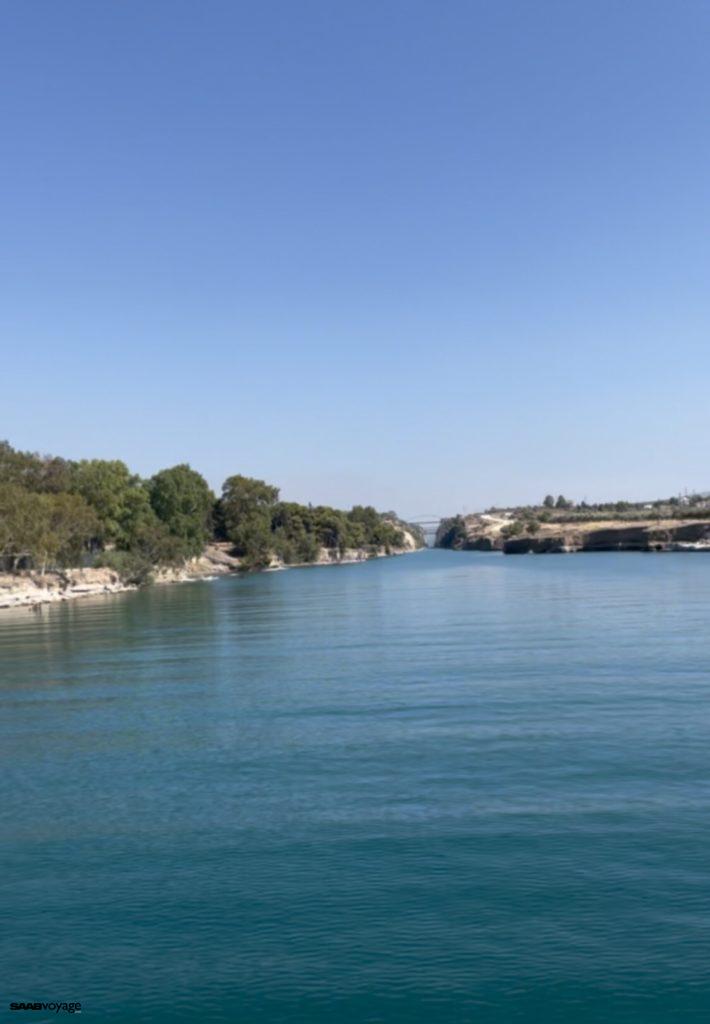
Sunion
From Corinth we drove to Athens, but before we got there we visited Sunion. There is a temple of Poseidon, which looks particularly picturesque at sunset.
Be warned, the gate is closed just as the sun sets, so you may get bounced off the guard.
There is free parking near the ticket office and café (below the hill with the temple itself), so there is no reason to park in the bushes.
We arrived at 7 p.m. and sunset was due at 8:06 p.m. From the top, you can see the bay with the boats moored. This view and the temple against the setting sun are two ready images to photograph.
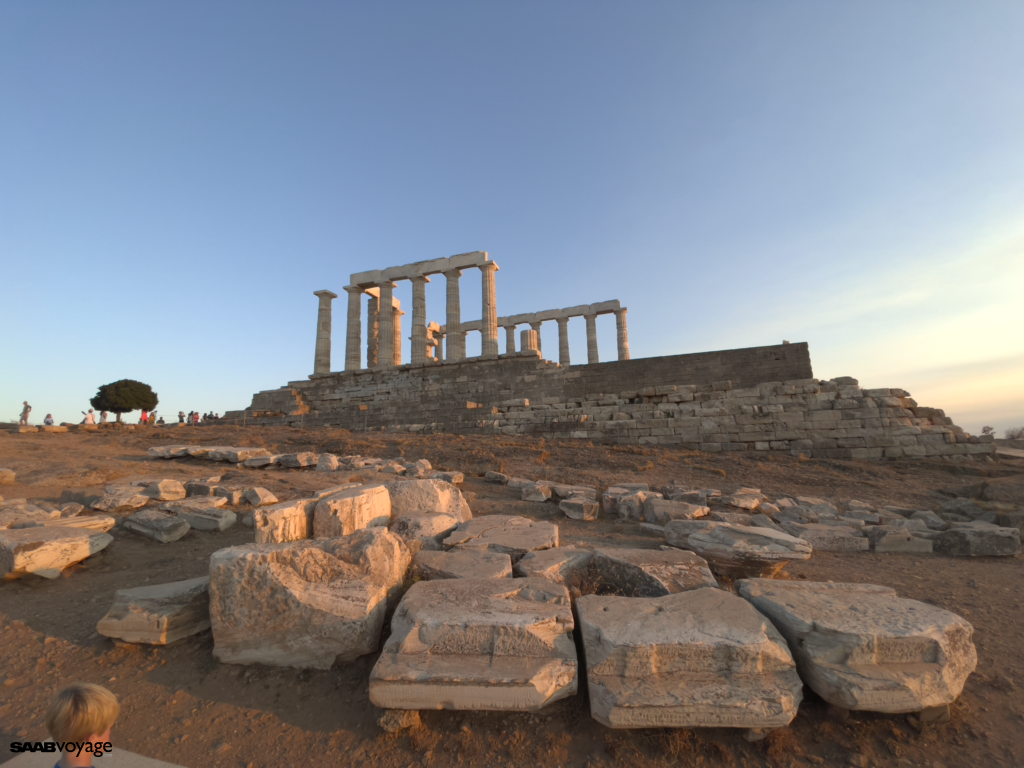
The temple itself is very nice, but what is interesting is the historical vandal marks from 100-200 years ago, like “here I was, Tom, 1806)
When descending the hill via the path at the back, it’s worth remembering that the exit (and gate) is halfway up the hill, so if you get too worked up you’ll have to climb back up the hill to successfully exit the facility.
Below is the temple of Athena, but in the face of the other surrounding temples, this one does not knock you out.
On the way to Sunion we saw the effects of the fires up close. The burnt slopes are really impressive. And then we also saw what it looks like to extinguish a fire with a plane.
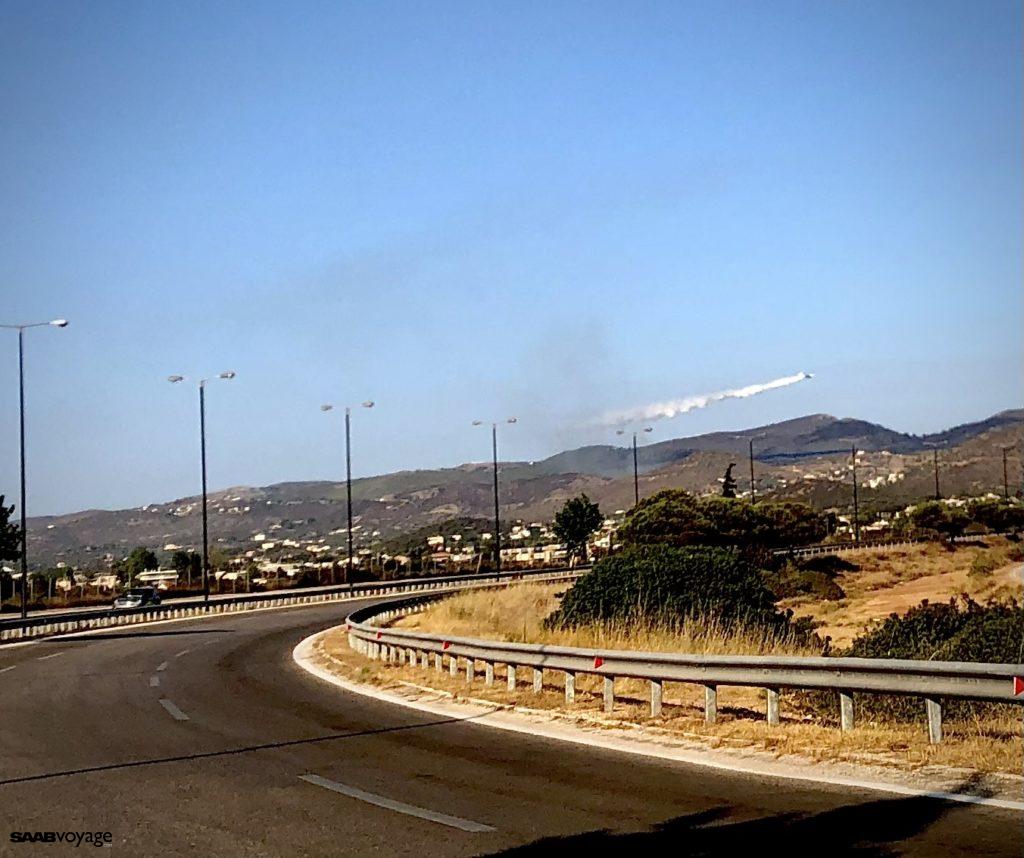
The presence of fire brigades here and there no longer comes as a surprise.
At the end of the day, we arrived in Athens, at our place in the aparthotel.
A strange city. In the centre, beautiful boulevards and luxury shop windows, and just 500 metres away from a post-apocalyptic area. At the National Bank of Greece, in the evening, homeless people put up their sleeping bags.
Finding paid parking in the centre of Athens is a challenge. The person at the hotel gave us several addresses, the car parks were either full, closed, or closed because they were full. And on the street there just aren’t spaces. Eventually, we managed to find free parking, but further away than closer.
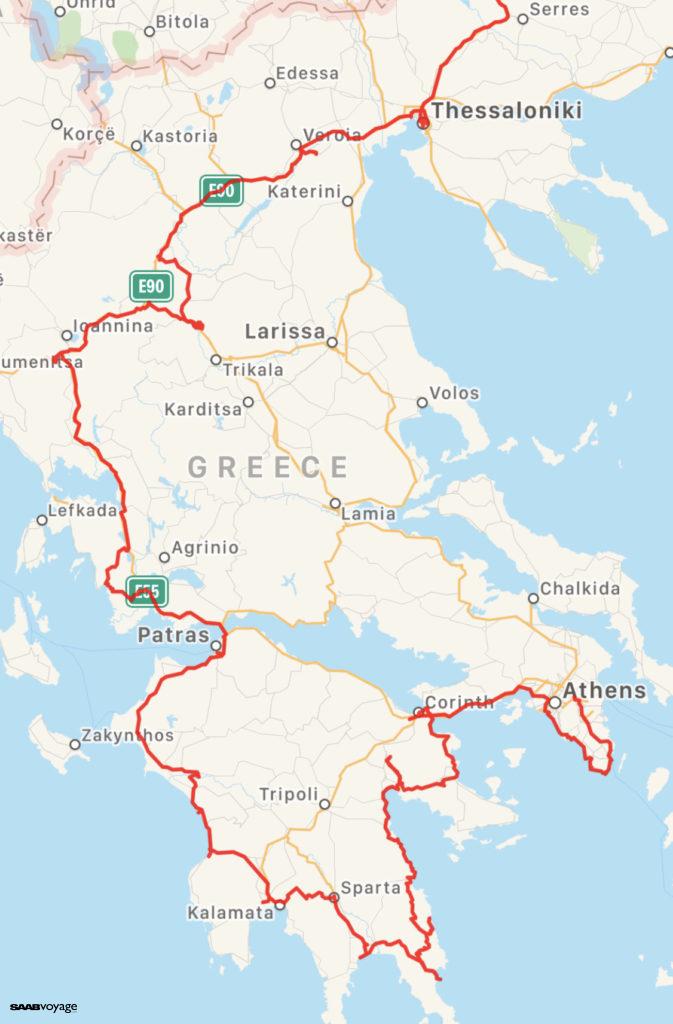
Wednesday – Athens day one, walking.
It was a day of walking around Athens. The plan was simple from A to Z: from the Acropolis to the temple of Zeus.
In the centre of Athens you have to try very hard not to have something ancient in sight.
We arrived by metro to the Acropolis, and there are – on the walls – copies of marble reliefs from the Parthenon, which the English took away in 1812 and somehow are not eager to give them back (Lord Byron himself was against the plunder of Greece, he even wrote the poem about it)
On that day we wanted to literally rub shoulders with antiquity.
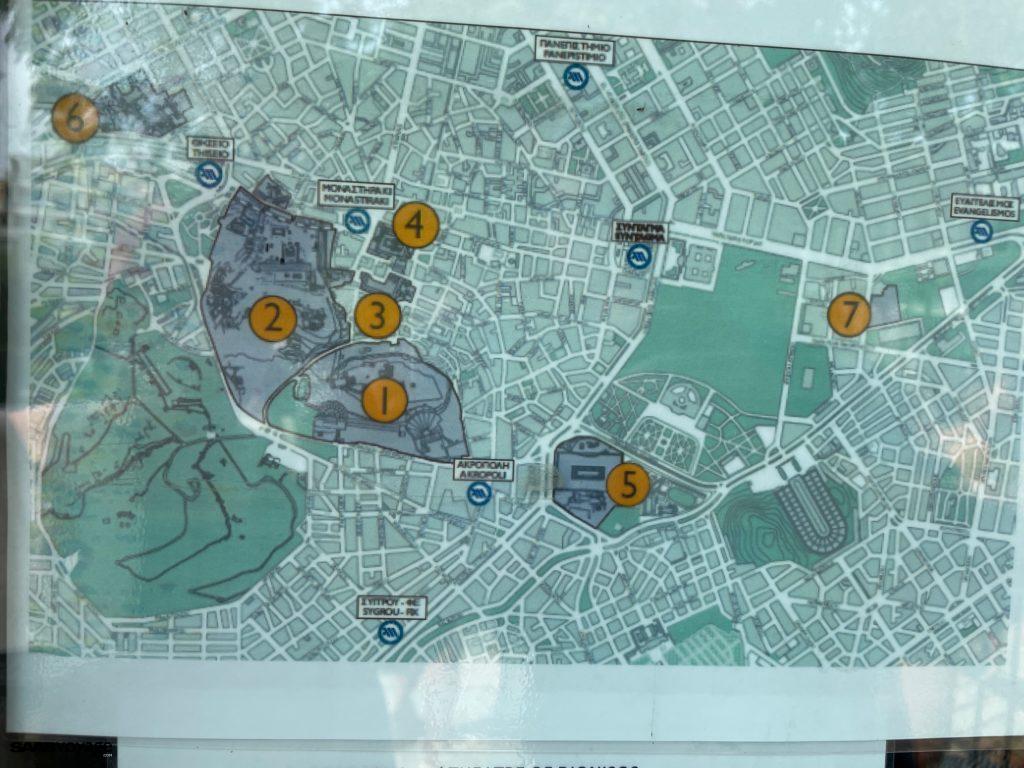
A handful of practical notes on visiting the Acropolis Hill:
- The Acropolis is a hill, so be prepared to do a lot of walking uphill
- do not bring anything other than water
- in the area, you can buy water from a vending machine downstairs, at the ticket offices, and then no more
- at the top, there is a set direction for the tour and the staff make sure you do not go against the direction
Here also there is a staff with whistles, which whistles those who do not understand that on old pebbles it is not possible to enter or to sit down.
The Acropolis is a continuous construction site. Individual monuments are being renovated, but not brought back to their original state.
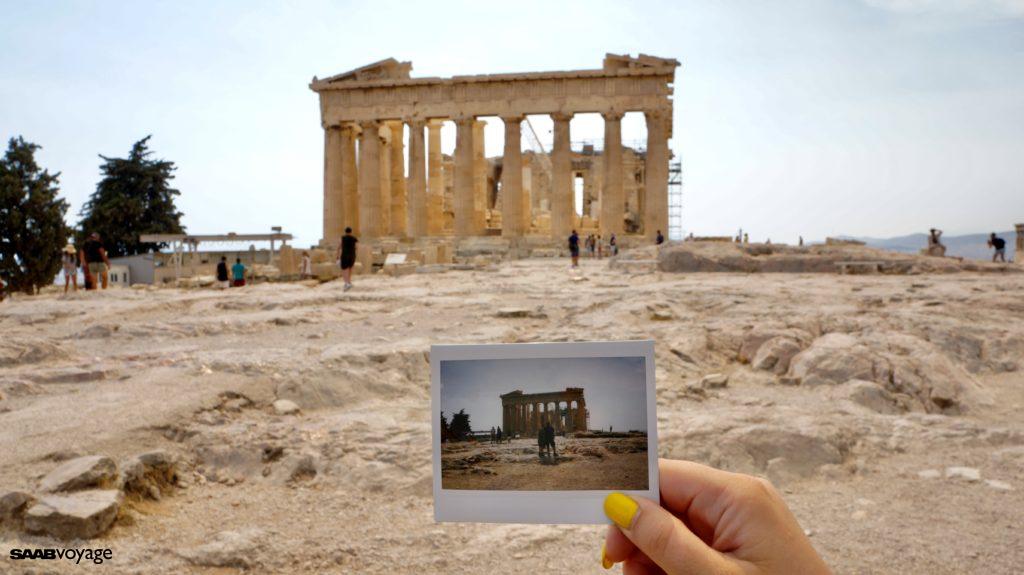
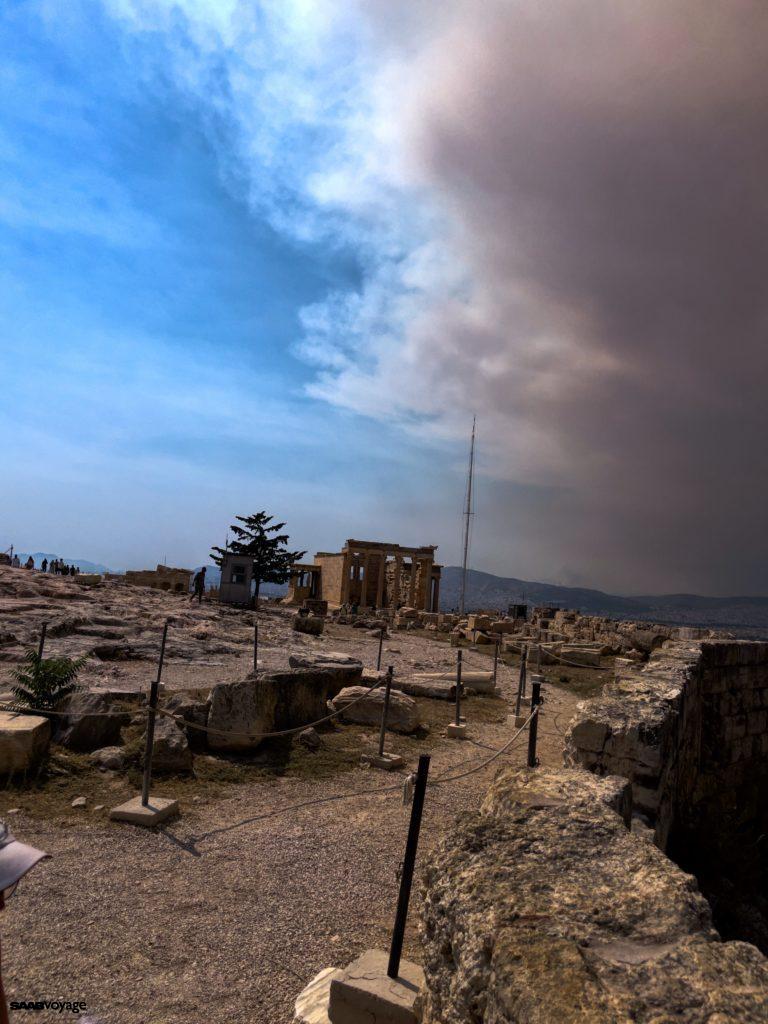
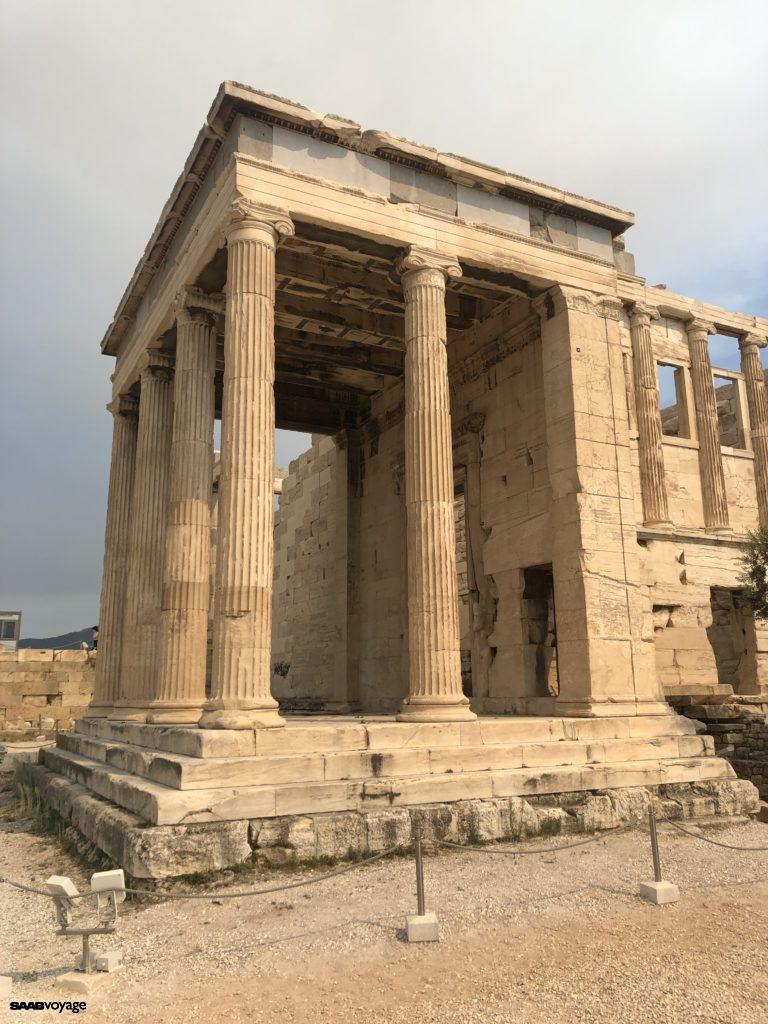
We were wondering what is the best order to visit Greece. If we saw the Acropolis at the very beginning, there would be a wow effect. But if we were there at the very end, after all the amazing sites and museums, it would be like the icing on the cake. But remember, it is more of a tourist attraction than a historical one.
So, guide in hand and you should go and visit.
In the centre of the city stands such an object. It is Hadrian’s Arch, the former border between Greek and Roman Athens. Nowadays, it completely blends in with the buildings (joke).
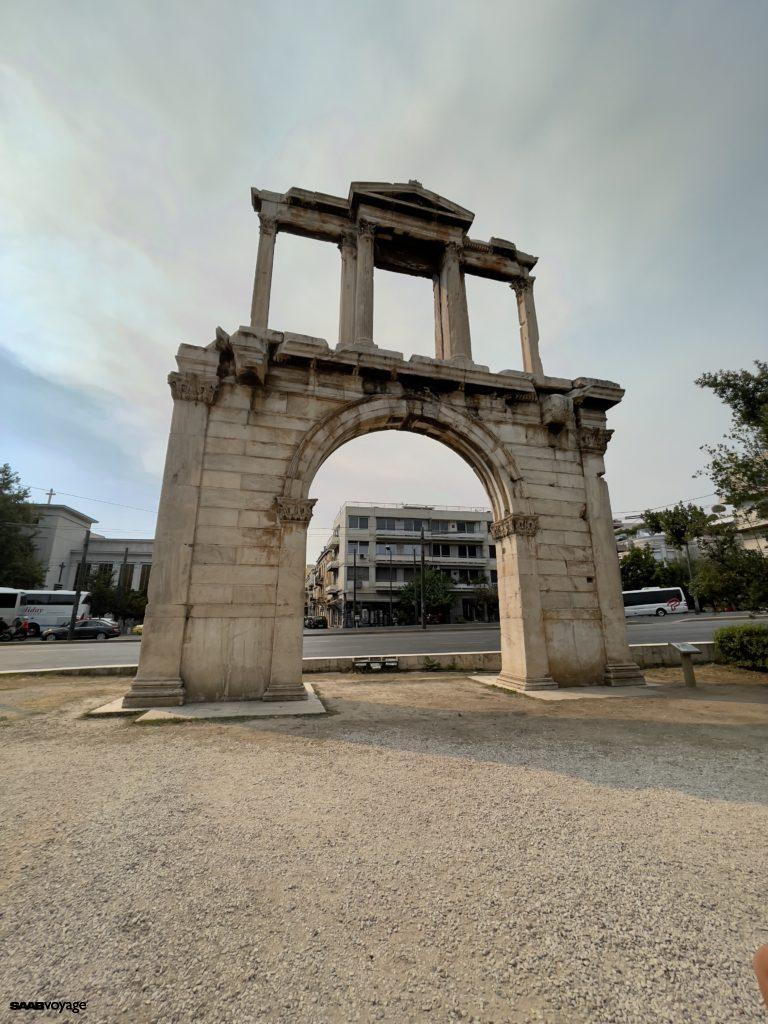
The Temple of Zeus is such a sad little place. It was built for over 600 years, and then when it fell apart, it was looted by the local people and not much remains of it. Originally it had 108 columns. Inside was a copy of the statue of Zeus by Phidias, a statue we would have seen in Olympia if it was still there.
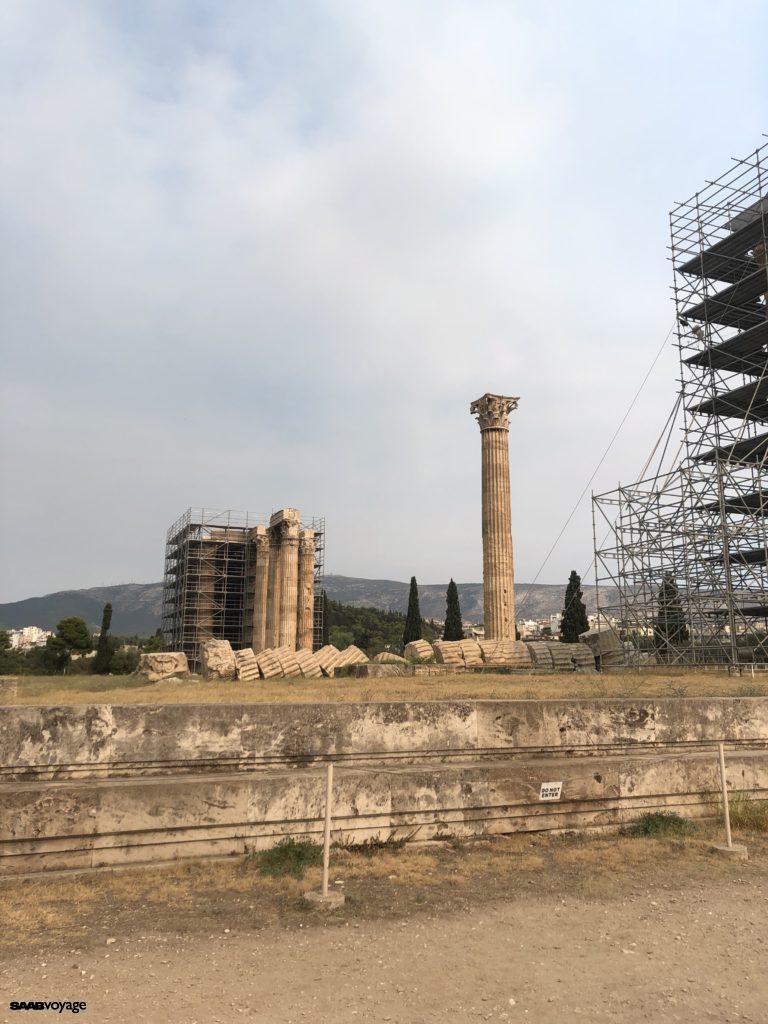
The area at the foot of the Acropolis, full of streets, houses and shops is Plaka. Such Athenian shopping streets. Here you can buy souvenirs, food, clothes. Fortunately, much of it is made here, in the neighbourhood. And that’s how two real Greek linen dresses were added to my household inventory.
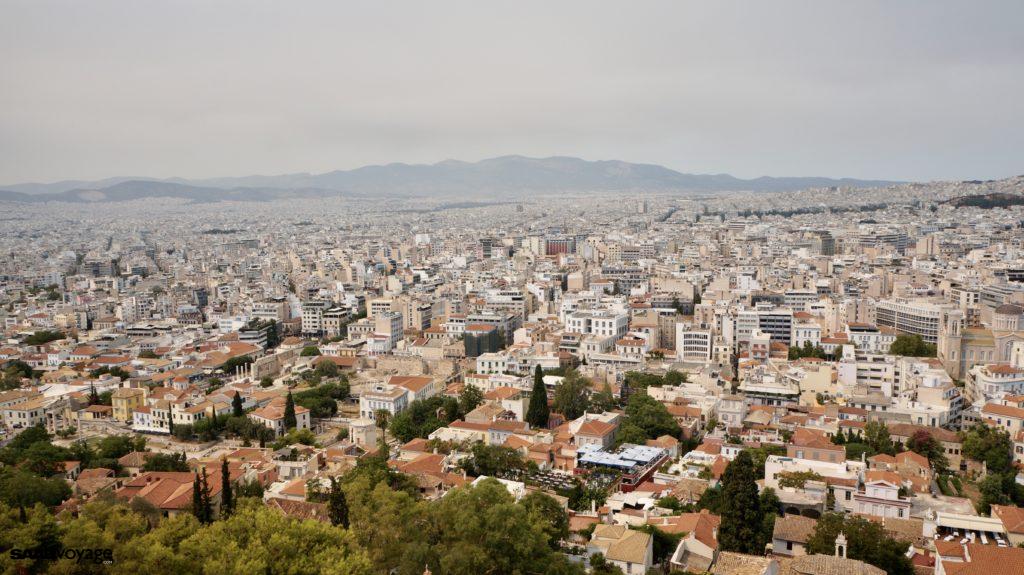
The magic of our saabvoyage tourism is that we get to interact with people with similar passions. In the evening, we met up with an Instagram friend who drives a 9-3. Sightseeing is one thing, but just talking to someone who lives here every day gives you a better understanding of the places we saw.

Thursday – Athens second day, museums
Hellenic Motor Museum
Museum day. The first fire went to a private motor museum.
The owners selected the cars according to a key known to them (we later found out that the collection had one common idea at the beginning: to fulfil the owner’s childhood dreams).
There are about 300 pieces in the collection. However, there are about a hundred cars on display. This museum did not knock us on our knees. We have come across similar establishments several times before. As if not to look far, there is the Classic Remise in Berlin. Let’s skip Otrębusy near Warsaw. Quite along the same lines here we have the Tiriac Collection in Bucharest. What we lacked in it was a story. A story told, the keynote of the collection being built, which was at the beginning. It is not clear what connects these cars. But that doesn’t make this place stand out either. It is rather a typical approach.
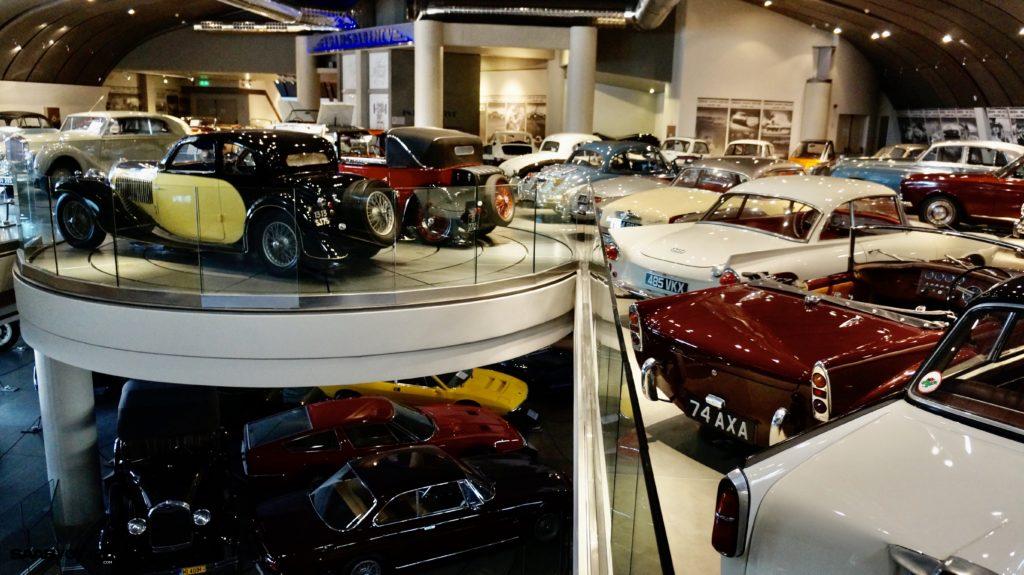

It was an interesting idea to gather the red cars on one floor alone.
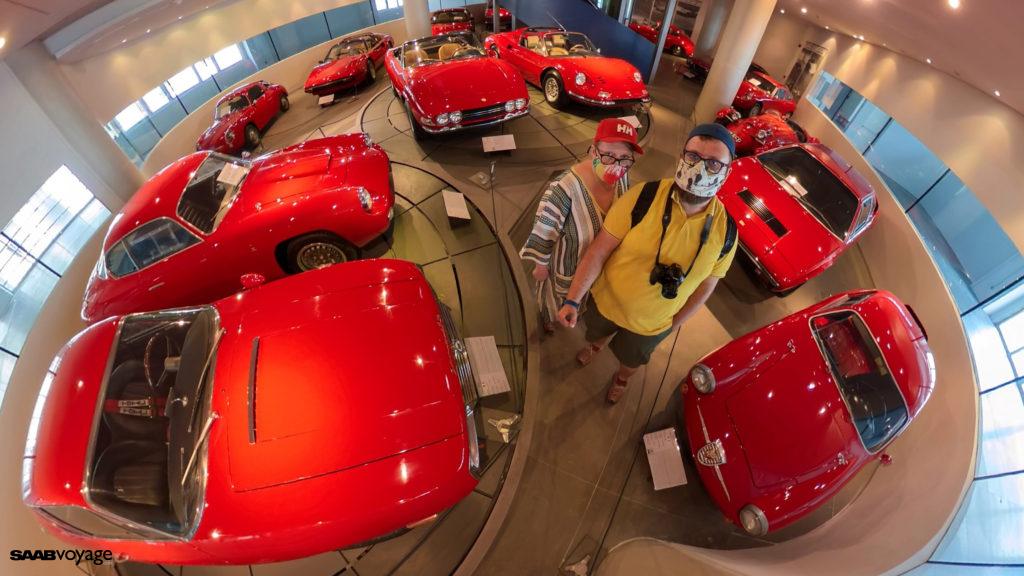
Either way, the museum is worth a visit, especially as the exhibition changes. A must for motoring fans.
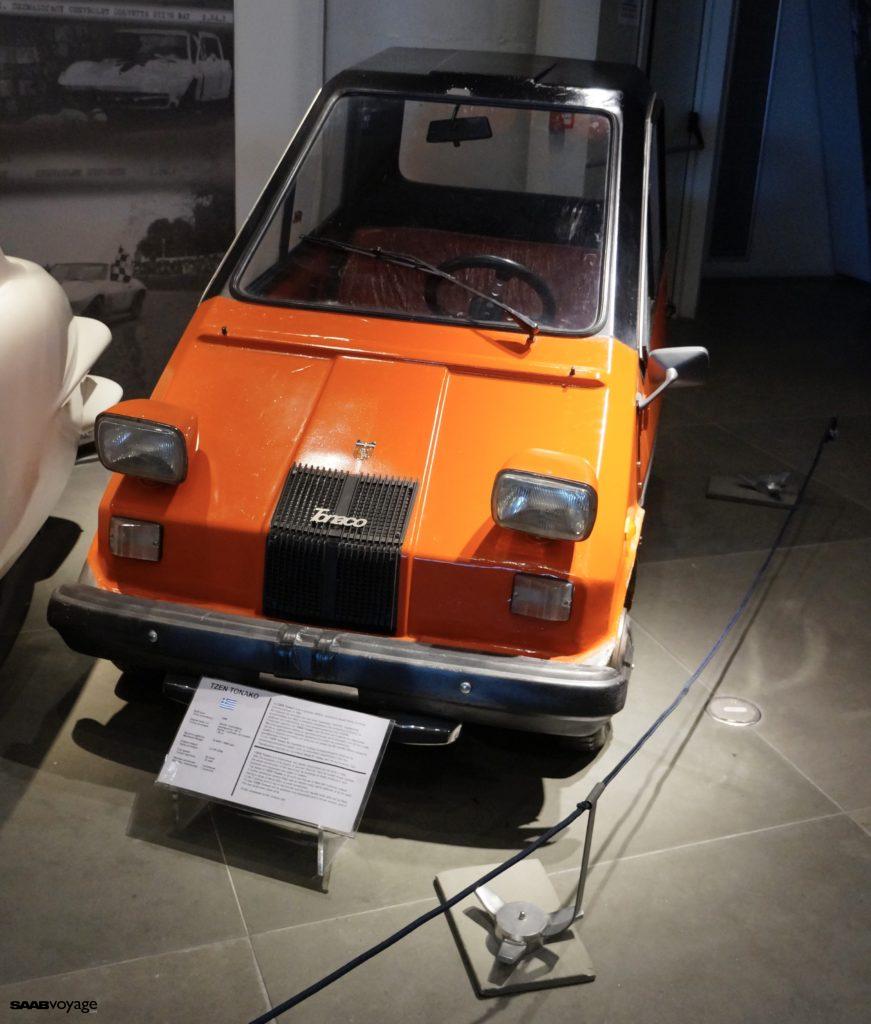
We spent the next few hours in Athens’ famous archaeological museum.
National Archaeological Museum of Athens
It is one of the 10 largest archaeological museums in the world. In short: a great storehouse of what’s important.
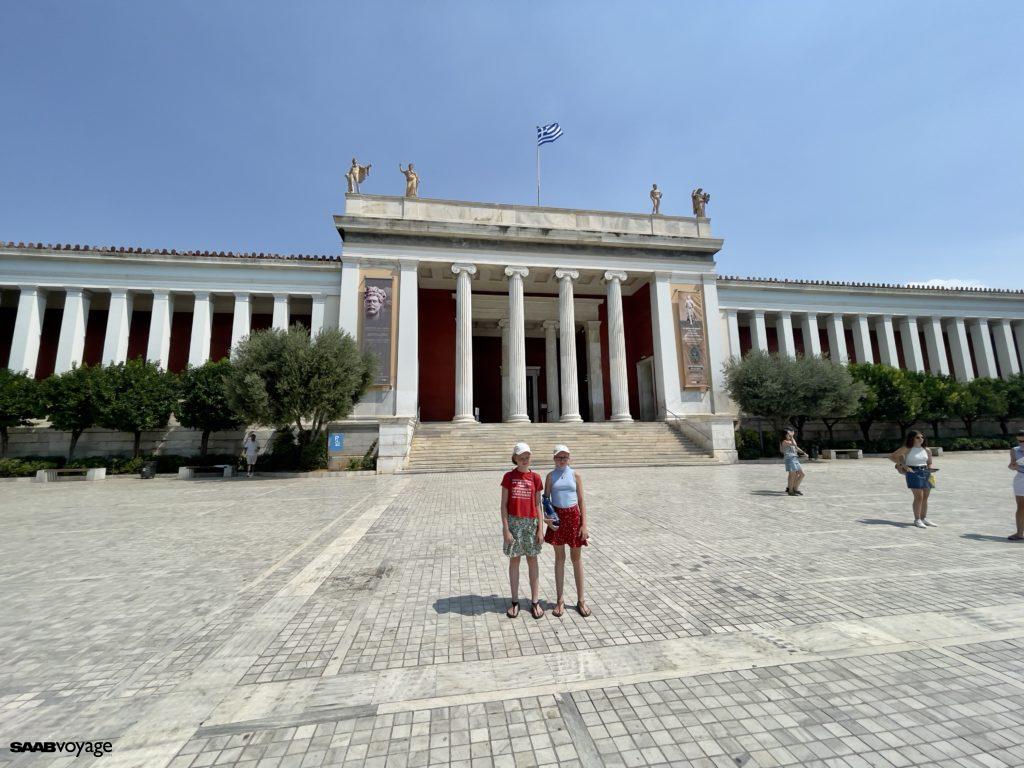
You need to prepare yourself to come here and see it consciously. There are two ways to prepare: to read books and guide books dryly or to go around Greece beforehand. There was no explanation of what it was all about and how one civilisation displaced another and why.
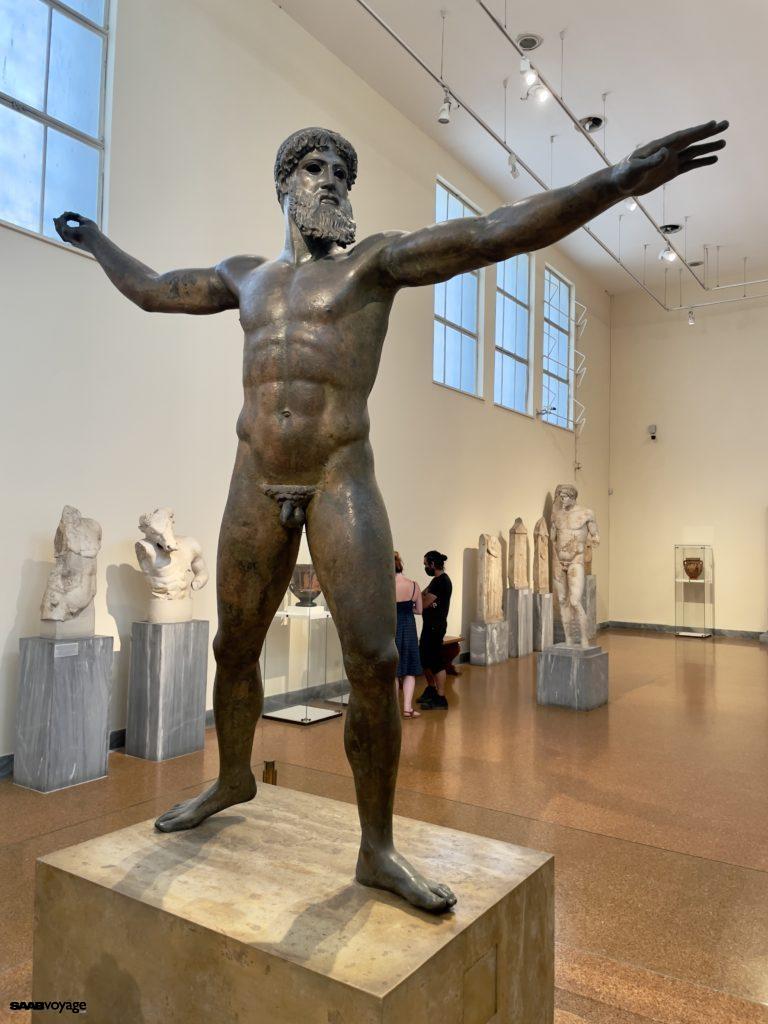
It’s certainly different to visit the museum first, looking at “some stuff”, and different at the end, like a summary of the whole Greek tour.
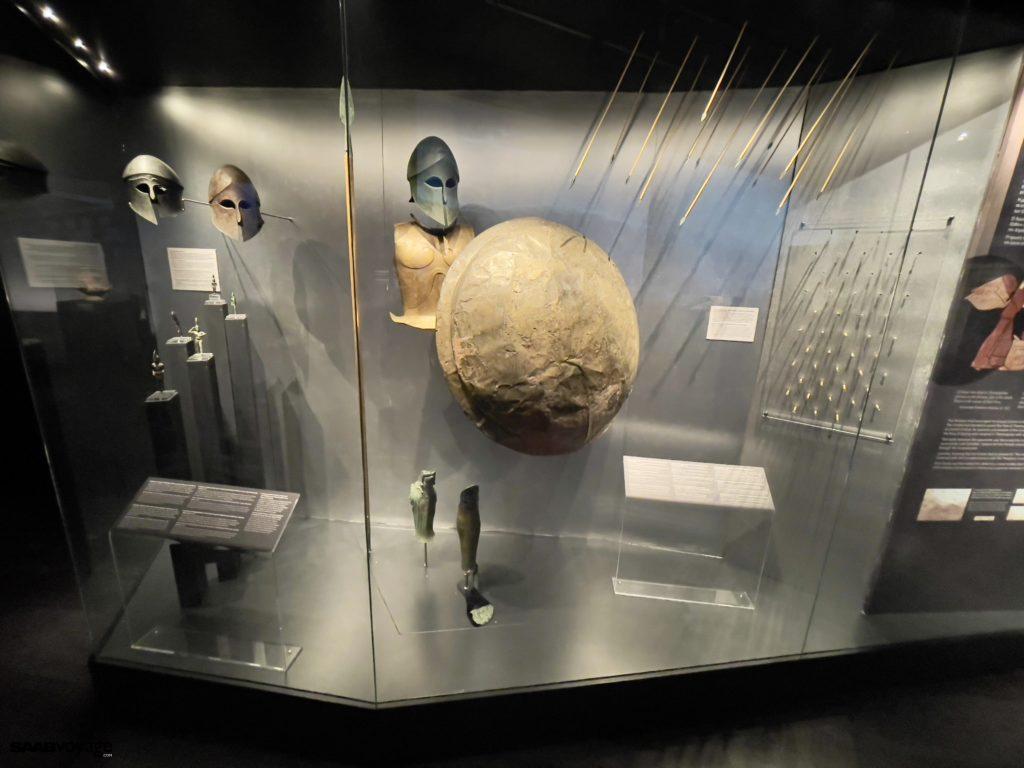
This is where you will find artefacts brought back from other places that we have already seen before. That is, for example, the 14 kg of gold from Mycenae. The non-Agamemnon mask (Schliemann thought he had excavated the Agamemnon mask, but it turned out to be a tiny 300-400 years older).
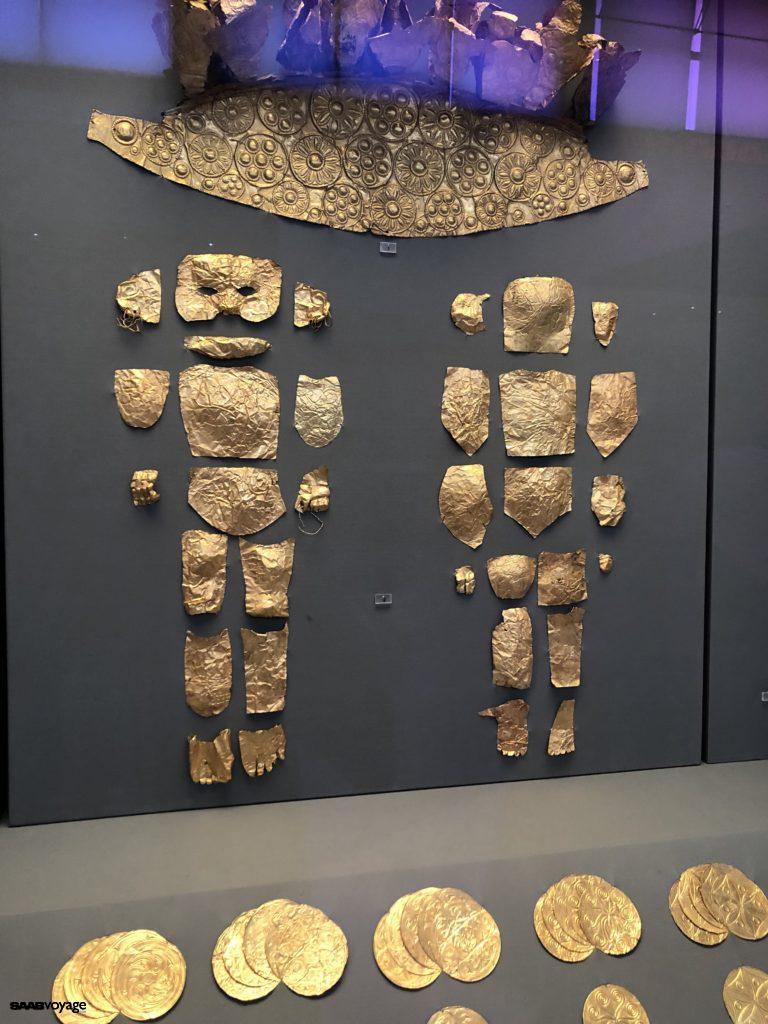
We were impressed by the temporary exhibition on victories, where we saw the helmet of Menelaus from Marathon, and a separate exhibition on the mysterious device used in antiquity to determine the dates of everything.
In general, it contains almost all the major movable monuments of Ancient Greece.
From practical information:
- You have to leave your backpack in the cloakroom, so you have to pack smartly;
- You have to be prepared for a lot of walking, we spent there 4 hours and left unsatisfied. It would be better to book 5-6h.
- There is a café on the grounds of the museum, so in case of emergency you can sit down, have a snack, a coffee and … return to sightseeing.
- The staff are friendly and knowledgeable. You can ask about an exhibit and get an explanation of how to get there. Like in a decent DIY store “third aisle to the left, straight, straight and after the ceramics to the right”.
Postcards
And here we run into the standard problem – where to buy stamps.
The kiosks sell cards, but not stamps. In the end, we found this one special kiosk and we had something to stick on. And then we went in search of a mailbox that would encourage confidence and give hope that the cards would arrive.
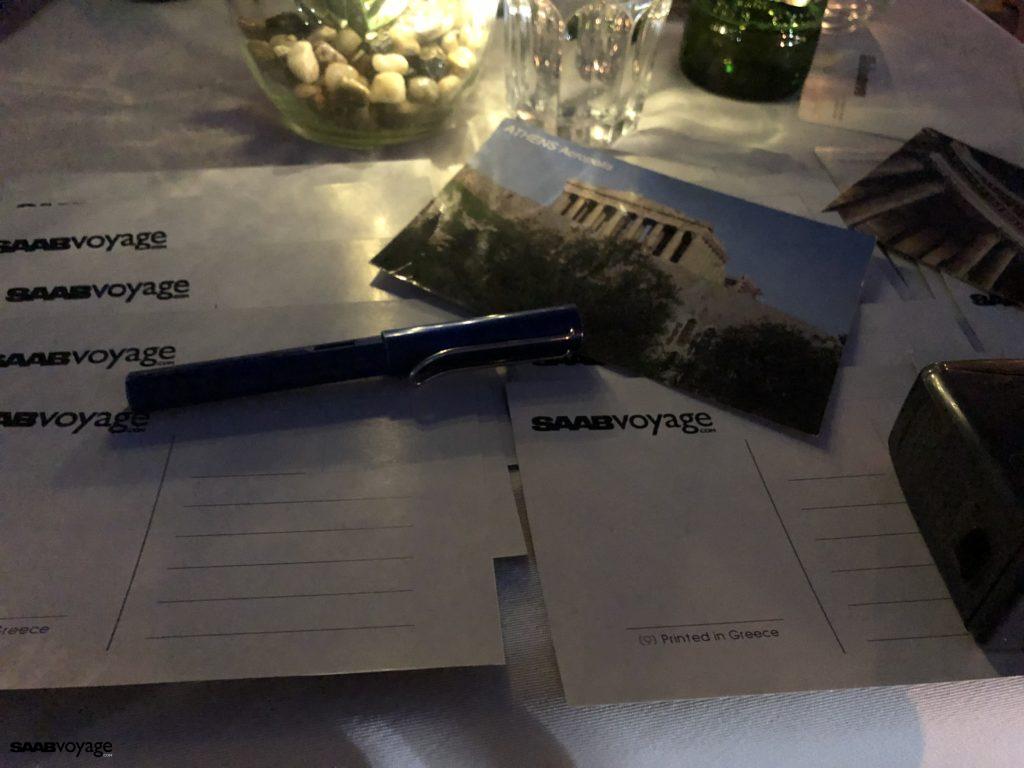
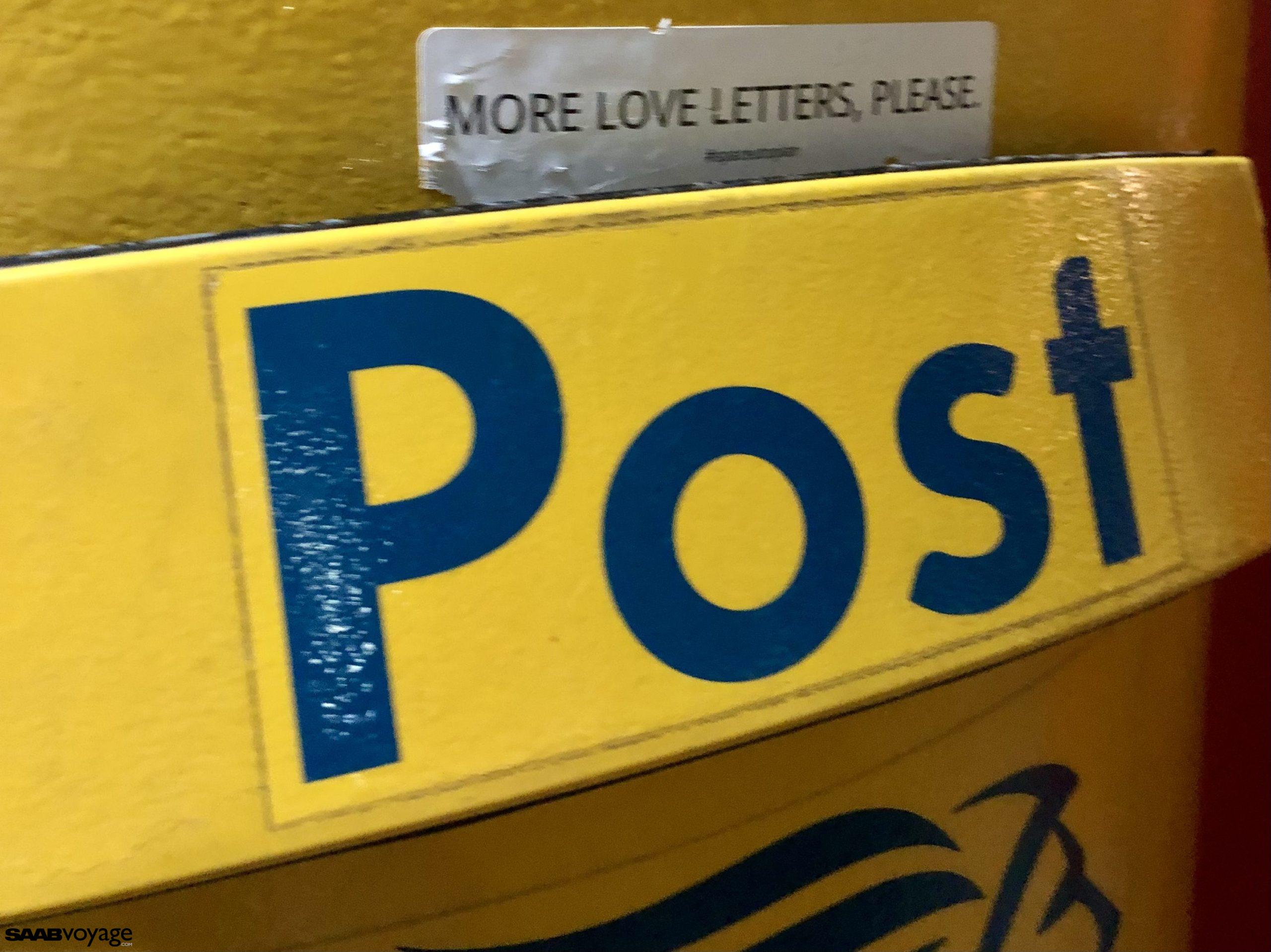
In both Thessaloniki and Athens we noticed a lot of closed down establishments. The city gets dirty fast enough that it was hard for us to identify whether it was the effect of covid, the crisis, or whether the venue had closed even earlier, or perhaps a longer holiday?
We also noticed a lot of abandoned unfinished buildings, hotels, etc., even in the very centre. So undeveloped, unfinished, abandoned. Just a curiosity.
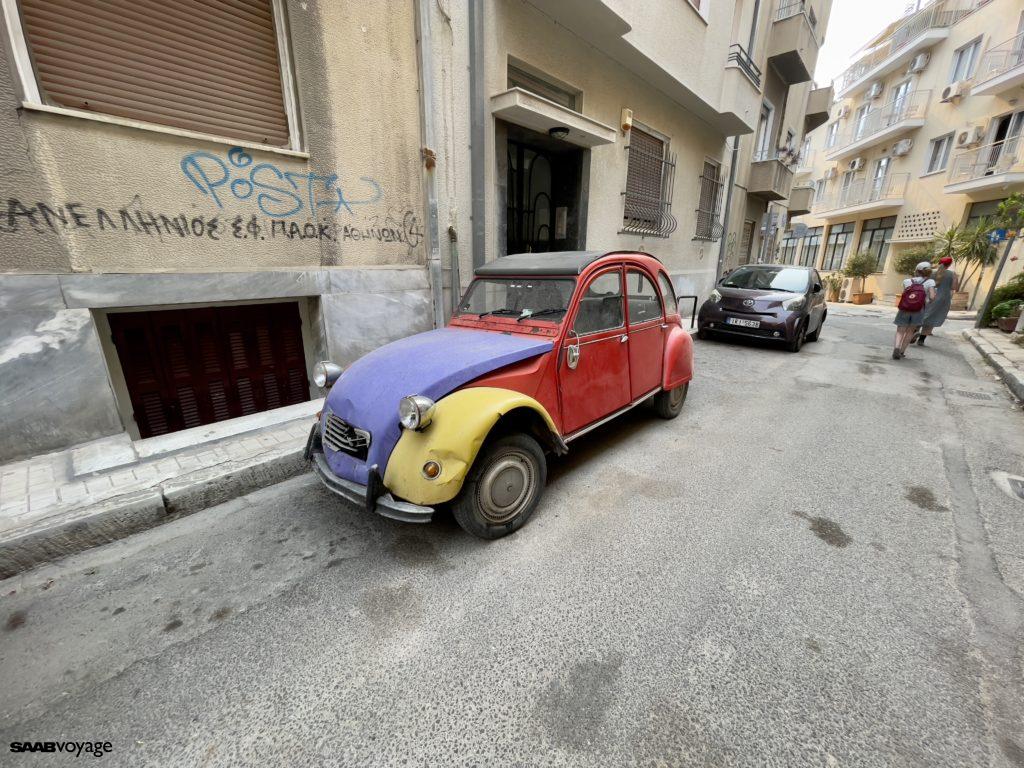
You can read what happened next in the last part of our notes.
Did you like the text? Now it’s your turn. We’ll be happy to stay in touch:
- Comment, for you it’s a moment, for us it’s a very important clue.
- If you think this post is valuable or would like to share with other readers – share our post – it means that you appreciate our work.
- Keep in touch, like us on Facebook or Instagram. Every day new photos, inspirations, interesting information.
